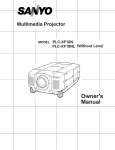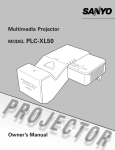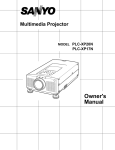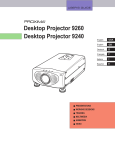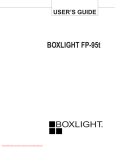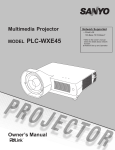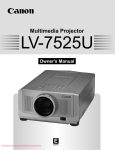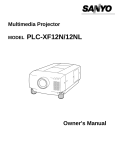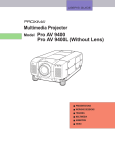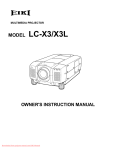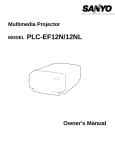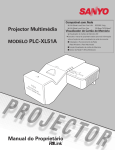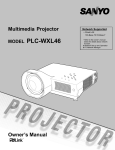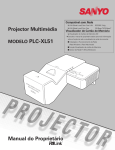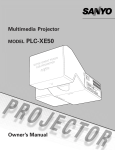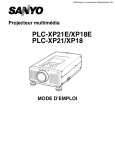Download Sanyo PLC-EF10NAL User's Manual
Transcript
Multimedia Projector
MODEL PLC-EF10NA
MOD
PLC-EF10NAL (Without Lens)
Owner's
Manual
INFORMATION TO THE USER
NOTE : This equipment has been tested and found to comply with the limits for a Class A digital device,
pursuant to Part 15 of FCC Rules. These limits are designed to provide reasonable protection
against harmful interference when the equipment is operated in a commercial environment. This
equipment generates, uses, and can radiate radio frequency energy and, if not installed and used
in accordance with the owner's manual, may cause harmful interference to radio communications.
Operation of this equipment in a residential area is likely to cause harmful interference in which
case the user will be required to correct the interference at his own expense.
TO THE OWNER
As the owner of a new Multi-media Projector, you are probably eager to try out your new projector. Before you do, we suggest
that you spend a little time reading this manual to familiarize yourself with the operating procedures, so that you will receive
maximum satisfaction from the many features included in your new projector.
This owner's manual will acquaint you with your projector's features. Reading it will help us too. Through the years, we have
found that many service requests were not caused by problems with our projectors. They were caused by problems that
could have been prevented, if the owner had followed the instructions in the manual.
You can often correct operating problems yourself. If your projector fails to work properly, see "TROUBLESHOOTING"
section on pages 55 ~ 56 and try the solutions marked for each problem.
SAFETY PRECAUTIONS
WARNING:
TO REDUCE THE RISK OF FIRE OR ELECTRIC SHOCK, DO NOT EXPOSE THIS APPLIANCE TO RAIN OR MOISTURE.
This Projector has a grounding-type AC line plug. This is a safety feature to be sure that the plug will fit into the
power outlet. Do not try to defeat this safety feature.
Intense light source. Do not stare directly into the projection lens as possible eye damage could result.
Be especially careful that children do not stare directly into the beam.
The Remote Control Unit, supplied to this projector, emits the laser beam as the Laser Pointer function from the
Laser Light Window while pressing the LASER button. Do not look into the Laser Light Window or shine the laser
beam on yourself or other people. Eye damage may result.
If the Projector will not be used for an extended time, unplug the new Projector from the power outlet.
This Projector should be set in the way indicated. Never hang the projector, or fall down on its side.
It may result in fire hazard.
READ AND KEEP THIS OWNER'S MANUAL FOR LATER USE.
CAUTION
RISK OF ELECTRIC SHOCK
DO NOT OPEN
CAUTION : TO REDUCE THE RISK OF ELECTRIC SHOCK, DO NOT REMOVE COVER (OR BACK).
NO USER-SERVICEABLE PARTS INSIDE EXCEPT LAMP REPLACEMENT. REFER
SERVICING TO QUALIFIED SERVICE PERSONNEL.
THIS SYMBOL INDICATES THAT
DANGEROUS VOLTAGE CONSTITUTING
A RISK OF ELECTRIC SHOCK IS
PRESENT WITHIN THIS UNIT.
2
THIS SYMBOL INDICATES THAT THERE
ARE IMPORTANT OPERATING AND
MAINTENANCE INSTRUCTIONS IN THE
OWNER'S MANUAL WITH THIS UNIT.
IMPORTANT SAFETY INSTRUCTIONS
All the safety and operating instructions should be read
before the product is operated.
Unplug this projector from wall outlet and refer servicing to
qualified service personnel under the following conditions:
Read all of the instructions given here and retain them for
later use. Unplug this projector from AC power supply
before cleaning. Do not use liquid or aerosol cleaners. Use
a damp cloth for cleaning.
a.
b.
c.
d.
When the power cord or plug is damaged or frayed.
If liquid has been spilled into the projector.
If the projector has been exposed to rain or water.
If the projector does not operate normally by following the
operating instructions. Adjust only those controls that are
covered by the operating instructions as improper
adjustment of other controls may result in damage and
will often require extensive work by a qualified technician
to restore the projector to normal operation.
e. If the projector has been dropped or the cabinet has been
damaged.
f. When the projector exhibits a distinct change in
performance-this indicates a need for service.
Do not use attachments not recommended by the
manufacturer as they may cause hazards.
Do not place this projector on an unstable cart, stand, or
table. The projector may fall, causing serious injury to a
child or adult, and serious damage to the projector. Use
only with a cart or stand recommended by the
manufacturer, or sold with the projector. Wall or shelf
mounting should follow the manufacturer's instructions,
and should use a mounting kit approved by the
manufacturer.
Do not expose this unit to rain or use near water... for
example, in a wet basement, near a swimming pool, etc...
When replacement parts are required, be sure the service
technician has used replacement parts specified by the
manufacturer that have the same characteristics as the
original part. Unauthorized substitutions may result in fire,
electric shock, or injury to persons.
Slots and openings in the back and bottom of the cabinet
are provided for ventilation, to insure reliable operation of
the equipment and to protect it from overheating.
Upon completion of any service or repairs to this projector,
ask the service technician to perform routine safety checks
to determine that the projector is in safe operating condition.
The openings should never be covered with cloth or other
material, and the bottom opening should not be blocked by
placing the projector on a bed, sofa, rug, or other similar
surface. This projector should never be placed near or
over a radiator or heat register.
This projector is equipped with a
grounding type AC line plug.
Should you be unable to insert the
plug into the outlet, contact your
electrician. Do not defeat the safety
purpose of this grounding type plug.
GROUND
This projector should not be placed in a built-in installation
such as a bookcase unless proper ventilation is provided.
Follow all warnings and instructions marked on the
projectors.
This projector should be operated only from the type of
power source indicated on the marking label. If you are not
sure of the type of power supplied, consult your authorized
dealer or local power company.
For added protection to the projector during a lightning
storm, or when it is left unattended and unused for long
periods of time, unplug it from the wall outlet. This will
prevent damage due to lightning and powerline surges.
Do not overload wall outlets and extension cords as this
can result in fire or electric shock. Do not allow anything to
rest on the power cord. Do not locate this projector where
the cord will be abused by persons walking on it.
An appliance and cart combination
should be moved with care. Quick
stops, excessive force, and uneven
surfaces may cause the appliance
and cart combination to overturn.
Never push objects of any kind into this projector through
cabinet slots as they may touch dangerous voltage points
or short out parts that could result in a fire or electric
shock. Never spill liquid of any kind on the projector.
If the projector is to be built into a compartment or similarly
enclosed, the minimum distances must be maintained.
Do not cover the ventilation slot on the projector.
Heat build-up can reduce the service life of your projector,
and can also be dangerous.
50cm
Do not attempt to service this projector yourself as opening
or removing covers may expose you to dangerous voltage
or other hazards. Refer all servicing to qualified service
personnel.
WALL
PROJECTOR
(FRONT)
50cm
PROJECTOR
(SIDE)
50cm
50cm
3
TABLE OF CONTENTS
PAGE
PAGE
FEATURES AND DESIGN
5
INTRODUCTION
5
COMPATIBILITY
IMAGE RESOLUTION
5
5
AUTOMATIC MULTISCANNING SYSTEM
SCREEN MODE
MULTILANGUAGE
UNPACKING THE PROJECTOR
TRADEMARKS
5
5
5
5
5
INSTALLATION
NAME OF EACH PART OF THE PROJECTOR
SETTING-UP THE PROJECTOR
MOVING THE PROJECTOR
POWER REQUIREMENTS
CONNECTING THE PROJECTOR
TERMINAL OF THE PROJECTOR
CONNECTING THE COMPUTER
CONNECTING THE VIDEO EQUIPMENT
BEFORE OPERATION
CONTROLS AND INDICATOR
OPERATION OF THE REMOTE CONTROL
WIRELESS REMOTE CONTROL UNIT
WIRELESS REMOTE CONTROL UNIT
CONTROL THE PROJECTOR
DIRECT OPERATION
MENU OPERATION
BASIC OPERATION
TURNING ON/OFF THE PROJECTOR
DIRECT OPERATION
MODE SELECT
SOUND VOLUME ADJUSTMENT
SOUND MUTE FUNCTION
ZOOM ADJUSTMENT
FOCUS ADJUSTMENT
LENS SHIFT ADJUSTMENT
DIGITAL ZOOM FUNCTION
NORMAL PICTURE FUNCTION
FREEZE PICTURE FUNCTION
NO SHOW FUNCTION
4
6-9
6
7
8
9
10-21
10-11
12-19
20-21
P-TIMER FUNCTION
AUTO IMAGE FUNCTION
CURSOR FUNCTION
MENU OPERATION
MODE SELECT
SOUND ADJUSTMENT
LANGUAGE ADJUSTMENT
VIDEO MODE
COLOR SYSTEM SELECT
VIDEO SOURCE SELECT
PICTURE IMAGE ADJUSTMENT
PICTURE SCREEN ADJUSTMENT
COMPUTER MODE
COMPUTER SYSTEM SELECT
COMPATIBLE COMPUTER SPECIFICATIONS
AUTO IMAGE FUNCTION
PICTURE IMAGE ADJUSTMENT
PICTURE POSITION ADJUSTMENT
PC ADJUSTMENT
PICTURE SCREEN ADJUSTMENT
34
34
34
35-36
35
36
36
37-39
37
37
38
39
40-49
40
41
42
43
44
45-48
49
22-31
22-23
24-28
24-26
27-28
29-31
29
30-31
32-51
32
33-34
33
33
33
33
33
33
34
34
34
34
OTHER FUNCTION SETTING
BLUE BACK
DISPLAY
REVERSE T/B
REVERSE L/R
SPLIT WIPE
POWER MANAGEMENT
USB (Mouse or Control)
REMOTE CONTROL (Mode 1 or Mode 2)
LAMP AGE
APPENDIX
MAINTENANCE
TEMPERATURE WARNING INDICATOR
AIR FILTER CARE AND CLEANING
LAMP REPLACEMENT
CLEANING THE LENS
TROUBLESHOOTING
TECHNICAL SPECIFICATIONS
50-52
50-51
50-51
50-51
50-51
50-51
50-51
50-51
50-51
52
53-57
53-55
53
53
54
55
55-56
57
FEATURES AND DESIGN
INTRODUCTION
The multimedia projector that combines powerful and sophisticated features with easy-to-use, intuitive controls. Built-in
multimedia features include audio, a palette of 16.77 million colors and active matrix liquid crystal display (LCD) technology.
The projector is ideal for high-performance business, training and imaging applications that demand exceptional color
quality.
COMPATIBILITY
The projector is compatible with many different types of personal computers and video devices, including:
● IBM-compatible computers, including laptops, up to 1600 x 1200 resolution.
● Apple Macintosh and PowerBook computers up to 1600 x 1200 resolution.
● Various VCRs, video disc players, video cameras, DVD players, satellite TV tuners or other AV equipment using any of the
worldwide video standards, including NTSC, NTSC4.43, PAL, PAL-M, PAL-N and SECAM.
IMAGE RESOLUTION
The resolution of the projector's projected image is 1280 x 1024. The projector displays computer images just as they appear
on your computer's monitor. Screen resolutions between 1280 x 1024 and 1600 x 1200 are compressed to 1280 x 1024. The
projector cannot display screen resolutions above 1600 x 1200. If your computer's screen resolution is higher than 1600 x
1200, reset it to a lower resolution before you connect the projector.
AUTOMATIC MULTISCANNING SYSTEM
This projector can detect display signals from most personal computers currently distributed. It is free from complicated
adjustments to project picture images from PC.
SCREEN MODE
Screen display can be selected among;
Computer mode
--- True, Digital zoom (Expand, Compress, Panning)
Video mode
--- Regular (4:3), Wide (16:9)
MULTILANGUAGE
MENU DISPLAY is displayed with; English, German, French, Italian, Spanish and Japanese.
UNPACKING THE PROJECTOR
The projector comes with the parts listed below. Check to find all the parts are included. If any parts are missing, contact an
authorized dealer or service station.
● Owner's Manual.
● AC Power Cord.
● Wireless Remote Control Unit.
● Wireless/Wired Remote Control Unit.
● Remote Control Cable.
● Batteries for Remote Control Units.
● Graphic Accelerator Board and its Software.
● Digital Flat Panel Cable.
● VGA Cable.
● Mouse Cable for PS/2 port.
● Mouse Cable for serial port.
● Mouse Cable for ADB port.
● VGA/MAC Adapter.
● Protective Dust Cover
● Lens Cover.
TRADEMARKS
●
●
●
●
Apple, Macintosh, and PowerBook are trademarks or registered trademarks of Apple Computer, Inc.
IBM and PS/2 are trademarks or registered trademarks of International Business Machines, Inc.
Windows is a trademarks or registered trademarks of Microsoft Corporation.
Other trademarks are the property of their respective owners.
5
FRONT OF THE PROJECTOR
REAR OF THE PROJECTOR
EXHAUST VENT
CAUTION HOT AIR!
Air blown from the exhaust vent is hot.
Observe the following when handling your
projector or choosing a location to install it.
● Keep heat-sensitive objects away from the
exhaust port.
● If you set the projector on top of a metallic
surface, the surface will become hot because of
the hot air exhaust. Be careful when handling.
● Do not touch the cabinet near to the exhaust
vent area, and especially screws and metallic
parts. These parts will become hot while the
projector is used.
6
INSTALLATION
SETTING-UP THE PROJECTOR
● This projector is basically designed to project on a flat projection surface.
● This projector can be focused from 4.9' (1.5 m) ~ 80.7' (24.6 m).
● Refer to the figure below as an example when positioning the projector to the screen.
POSITIONING:
THIS PROJECTOR SHOULD BE SET IN THE WAY INDICATED. NEVER HANG
THE PROJECTOR, OR FALL DOWN ON ITS SIDE. IT MAY RESULT IN FIRE
HAZARD.
ROOM LIGHT
Maximum Zoom
Minimum Zoom
The projector should be placed in a room with
limited light. Picture quality will be directly
affected by lightning conditions.
400"
100"
40"
600"
150"
200"
154"
77" 115"
300"
462"
231"
308"
DISTANCE
Screen Max. Zoom
Size
Min. Zoom
40"
Distance
100"
150"
200"
300"
400"
600"
77"
115"
154"
231"
308"
462"
4.9' (1.5 m) 13.1' (4.0 m) 20' (6.1 m)
26.9' (8.2 m) 40' (12.2 m) 53.8' (16.4 m) 80.7' (24.6 m)
ADJUSTABLE FEET
MOVE THE PROJECTED IMAGE POSITION
Adjust the projected image position (maximum 760mm
downward or upward on the 100" screen) by using lens shift
function. (See page 33.)
760 mm
Picture tilt and projection angle can be adjusted by twisting
ADJUSTABLE FEET. Projection angle can be adjusted up
to 4 degrees by rotating Adjustable Feet.
DOWN
UP
DOWN
UP
ADJUSTABLE FEET
760 mm
100"
SCREEN
7
INSTALLATION
VENTILATION
This projector is equipped with a cooling fan to protect it from
overheating. Pay attention to the following to ensure the ventilation
and avoid a possible risk of fire and malfunction.
● Do not cover the vents with papers or other materials.
● Keep the rear grill at least 3.3' (1m) away from any object.
● Make sure that there are no objects under the projector.
An object under the projector may prevent the projector
from taking the cooling air through the bottom vent.
AIR INTAKE VENT
(BOTTOM SIDE)
EXHAUST VENT
(REAR SIDE)
MOVING THE PROJECTOR
Use the carry handle when moving the projector.
Replace the lens cover and rotate the adjustable feet fully
clockwise.
CAUTION IN CARRYING OR TRANSPORTING THE PROJECTOR
● Do not drop or give a shock to the projector, otherwise damage or malfunction may result.
● When carrying the projector, use a Sanyo recommended Carrying Case.
● Do not transport the projector by using a courier or transport service in an unsuitable transport case. This may cause
damage to the projector. To transport the projector through a courier or transport service, use a Sanyo recommended
Case.
● For a carrying or transportation cases, contact a Sanyo authorized dealer.
8
INSTALLATION
POWER REQUIREMENTS
Your projector uses nominal input voltages of 100-120 VAC. The projector
automatically selects the correct input voltage. The projector is designed to work
with single-phase power systems having a grounded neutral conductor. To reduce
the risk of electrical shock, do not plug into any other type of power system.
Consult your authorized dealer or service station if you are not sure what type of
power is supplied to your building.
Projector side (Female)
AC outlet side (Male)
Connect the AC power supply cord
(supplied) to the projector.
The socket-outlet must be near this
equipment and must be easily
accessible.
9
CONNECTING THE PROJECTOR
TERMINAL OF THE PROJECTOR
9
8
10
USB 1
11
USB 2
6
CONTROL PORT 1
AUDIO 1
R
CONTROL PORT 2
13
SERIAL PORT
12
L
2
ANALOG
DIGITAL
(MONO)
AUDIO 2
R
R/C JACK
1
5
L
(MONO)
R
G
B
AUDIO OUT
R
ANALOG RGB
L
H
V
COMPUTER OUT COMPUTER IN-2 COMPUTER IN-1
SIDE OF THE PROJECTOR (CONNECT THE COMPUTER)
3
4
7
1
COMPUTER INPUT-1 TERMINAL (ANALOG HDB 15-PIN)
Used to connect a computer to the projector.
8
CONTROL PORT-1 CONNECTOR
Used to connect a mouse cable to the projector.
2
COMPUTER INPUT-1 TERMINAL (DIGITAL MDR 20-PIN)
Used to connect a computer to the projector.
9
CONTROL PORT-2 CONNECTOR
Used to connect a mouse cable to the projector.
3
COMPUTER INPUT-2 JACKS (BNC TYPE x 5)
Used to connect a computer to the projector.
10
USB PORT-1 CONNECTOR
Used to connect a computer to the projector.
4
MONITOR OUTPUT TERMINAL (ANALOG HDB 15-PIN)
Used to connect a monitor to the projector.
11
USB PORT-2 CONNECTOR
Used to connect a computer to the projector.
5
COMPUTER AUDIO INPUT-1 JACKS (R and L)
Used to connect an audio output from the computer to the
projector.
12
SERIAL PORT TERMINAL (DB9)
Used to connect a computer to the projector.
6
COMPUTER AUDIO INPUT-2 JACKS (R and L)
Used to connect an audio output from the computer to the
projector.
13
WIRED REMOTE JACK
When using the wired remote control, connect the
remote cable to this jack.
7
AUDIO MONITOR OUTPUT JACKS (R and L)
Used to connect an audio input from audio equipment to the
projector.
10
CONNECTING THE PROJECTOR
SIDE OF THE PROJECTOR (CONNECT THE VIDEO EQUIPMENT)
15
16
VIDEO IN-1
14
18
VIDEO/Y
C/Cb(B-Y)
Cr(R-Y)
S-VIDEO
AUDIO
R
L
(MONO)
19
20
MONITOR OUT
VIDEO IN-2
17
VIDEO/Y
C/Cb(B-Y)
Cr(R-Y)
S-VIDEO
AUDIO
R
L
(MONO)
22
VIDEO/Y
C/Cb(B-Y)
Cr(R-Y)
S-VIDEO
AUDIO
R
L
21
14
VIDEO INPUT JACKS-1 (BNC TYPE x 3)
Used to connect a video source to the projector.
19
AUDIO INPUT JACKS-2 (R and L)
Used to connect an audio source to the projector.
15
S-VIDEO INPUT JACK-1
Used to connect a S-VHS video source to the projector.
20
VIDEO MONITOR OUTPUT JACKS (BNC TYPE x 3)
Permits video connection to a monitor.
16
AUDIO INPUT JACKS-1 (R and L)
Used to connect an audio source to the projector.
21
VIDEO MONITOR (S-VIDEO) OUTPUT JACK
Permits S-VHS video connection to a monitor.
17
VIDEO INPUT JACKS-2 (BNC TYPE x 3)
Used to connect a video source to the projector.
22
AUDIO MONITOR OUTPUT JACKS (R and L)
Permits audio connection to a monitor.
18
S-VIDEO INPUT JACK-2
Used to connect a S-VHS video source to the projector.
11
CONNECTING THE PROJECTOR
CONNECTING THE COMPUTER
CONNECTING TO THE COMPUTER INPUT 1 TERMINAL (ANALOG HDB 15-PIN)
Personal computers can be connected to the HDB15-pin (VGA) terminal on the projector.
● Connect the computer to these terminals using the VGA cable and VGA/MAC adapter (provided).
CAUTION: For projectors, the VGA cable provided is designed to reduce RFI (Radio Frequency Interference) emissions.
For regulatory compliance reasons, this cable must be used and must not be replaced by any other cable.
CONNECTING TO THE COMPUTER INPUT 1 TERMINAL (DIGITAL MDR 20-PIN)
Digital output signal from the computer can be connected to the DIGITAL terminal (MDR 20-pin). When using this input,
Graphic Accelerator Board designed for this projector should be installed into your computer and set-up the computer
configuration following instruction included in the Graphic Accelerator Board package. Refer to DIGITAL INPUT
CONNECTION on page 15 and 17.
CONNECTING TO THE COMPUTER INPUT 2 JACKS (BNC x 5)
Personal computers can be connected to the computer input (Red, Green, Blue, Horiz. Sync. and Vert. Sync.) on the
projector.
● Connect the computer to these jacks using the BNC cables (not provided).
CONNECTING TO THE COMPUTER AUDIO INPUT JACKS (1 and 2)
● Connect audio outputs from your computer to these jacks using the audio cable (not provided).
CONNECTING TO THE MULTI-POLE 12-PIN (CONTROL PORT) CONNECTORS (1 and 2)
● When the computer is operated by projector's remote control unit, connect three different type of cables (provided)
between projector control port and computer mouse port or serial port.
COMPUTER TYPE
CABLE
IBM Compatible computer with PS/2 mouse port.
Mouse Cable for PS/2 port.
IBM Compatible computer with serial port.
Mouse Cable for Serial port.
Apple Macintosh computer with ADB mouse port.
Mouse Cable for ADB port.
■ CONTROL PORT
6
5
2
1
4
10
9
12
12
11
8
3
7
1
2
3
4
5
6
7
8
9
10
11
12
PS/2 Port
Serial Port
––––––––
CLK
DATA
––––––––
––––––––
––––––––
––––––––
––––––––
GND
––––––––
––––––––
––––––––
TxD
––––––––
––––––––
––––––––
––––––––
––––––––
READY
––––––––
GND
––––––––
––––––––
––––––––
ADB Port
––––––––
ADB
––––––––
––––––––
––––––––
––––––––
––––––––
––––––––
GND
––––––––
––––––––
––––––––
CONTROL PORT CABLE REMOVAL
HINT
Disconnect control port cable with
following steps.
1. Hold the portion (A)
of the connector
with one hand.
2. Pull the portion (B)
arrow direction and
remove connector.
B
A
CONNECTING THE PROJECTOR
CONNECTING TO THE MONITOR OUTPUT TERMINAL (ANALOG HDB 15-PIN)
This terminal output the information of the selected computer source being viewed on the screen (Computer 1 or Computer 2).
When video source ("Video 1" or "Video 2") is selected, this terminal outputs Computer 1 input information.
An external monitor can be connected to the HDB15-pin (VGA) terminal on the projector.
● Connect the monitor to this terminal using the VGA cable (not provided).
5
HDB 15-PIN
TERMINAL
4
10 9
3
2
8
1
7
6
15 14 13 12 11
Pin No./Signal
9 Non Connect
10 Ground (Vert. sync.)
11 Sense 0
12 Sense 1
13 Horiz. sync
14 Vert. sync
15 Reserved
Pin No./Signal
1 Red input
2 Green input
3 Blue input
4 Sense 2
5 Ground (Horiz.sync.)
6 Ground (Red)
7 Ground (Green)
8 Ground (Blue)
CONNECTING TO THE AUDIO MONITOR OUTPUT (VARIABLE) JACKS
These jacks will contain the audio information of the selected program source being viewed on the screen (Computer 1,
Computer 2, Video 1 or Video 2). If you have selected program source Computer 2 the audio signal connected to the
Computer 2 audio input jack will be available at the audio monitor output jacks.
Use RCA type audio for connection.
● If the audio input of the audio equipment is stereo, be sure to connect the right and left channels to the respective right
and left jacks.
● If the audio input of the audio equipment is monaural, connect it to the left jack.
CONNECTING TO THE SERIAL PORT (DB 9-PIN) TERMINAL
● If you control the projector by computer, you must connect a cable (not provided)
from your computer to this terminal.
■ SERIAL PORT
DB9-PIN
TERMINAL
5 4 3 2 1
9 8 7 6
1
2
3
4
5
6
7
8
9
––––––––
RxD
TxD
––––––––
Ground
––––––––
––––––––
––––––––
––––––––
1
2
3
4
Vcc
- Data
+ Data
Ground
CONNECTING TO THE USB PORT CONNECTORS (1 and 2)
This Projector is designed for connecting with USB Port of the computer or peripheral
equipment that is to be standard.
■ USB PORT
2
1
3
4
13
CONTROL PORT 1
AUDIO 1
R
USB 2 CONTROL PORT 2
14
SERIAL PORT
L
DIGITAL
ANALOG
(MONO)
AUDIO 2
R
R/C JACK
L
(MONO)
R
G
B
AUDIO OUT
R
L
ANALOG RGB
H
V
COMPUTER OUT COMPUTER IN-2 COMPUTER IN-1
USB 1
CONNECTING THE PROJECTOR
CONNECTING AN IBM-COMPATIBLE DESKTOP COMPUTER
(DIGITAL INPUT CONNECTION)
NOTE:
Before using with digital connection, install (Plug in) Graphic Accelerator Board (included within projector) into PCI
bus slot of the computer and set up the computer following instructions in the Graphic Accelerator Board package.
COMPUTER
MONITOR CABLE
(NOT PROVIDED)
INSTALL (PLUG)
INTO PCI BUS SLOT
SERIAL PORT
INPUT
COMPUTER
AUDIO OUTPUT
PS/2 PORT
INPUT
ANALOG
OUTPUT
DIGITAL FLAT
PANEL CABLE
(PROVIDED)
DIGITAL
OUTPUT
R
AUDIO CABLE
(NOT PROVIDED)
L
COMPUTER
AUDIO INPUT 1
R
USB 1
COMPUTER
INPUT 1
(DIGITAL)
L
CONTROL PORT 1
AUDIO 1
R
MOUSE CABLE FOR
PS/2 PORT
(PROVIDED)
USB 2 CONTROL PORT 2
SERIAL PORT
L
DIGITAL
ANALOG
(MONO)
AUDIO 2
R
R/C JACK
L
(MONO)
R
G
B
AUDIO OUT
R
L
ANALOG RGB
CONTROL PORT
OUTPUT 1
MOUSE CABLE FOR
SERIAL PORT
(PROVIDED)
H
V
COMPUTER OUT COMPUTER IN-2 COMPUTER IN-1
GRAPHIC
ACCELERATOR
BOARD
SERIAL
PORT
OUTPUT
SERIAL PORT CABLE
(NOT PROVIDED)
COMPUTER
AUDIO OUTPUT
AUDIO CABLE
(NOT PROVIDED)
AUDIO
INPUT
L
R
SPEAKER
OUT
L
Amp.
Speaker (L)
Speaker (R)
R
NOTE: When connecting the cable, the power cords of both the projector and the external equipment should be
disconnected from AC outlet. Turn the projector and peripheral equipment on before the computer is switched on.
15
CONNECTING THE PROJECTOR
CONNECTING AN IBM-COMPATIBLE LAPTOP COMPUTER
COMPUTER
VGA CABLE
(PROVIDED)
COMPUTER OUTPUT
(DB15-PIN TYPE)
AUDIO CABLE
(NOT PROVIDED)
R
SERIAL PORT
INPUT
COMPUTER
AUDIO OUTPUT
PS/2 PORT
INPUT
L
USB 1
R
CONTROL PORT 1
AUDIO 1
R
MOUSE CABLE FOR
PS/2 PORT
(PROVIDED)
USB 2 CONTROL PORT 2
MOUSE CABLE FOR
SERIAL PORT
(PROVIDED)
R/C JACK
SERIAL
PORT
OUTPUT
SERIAL PORT CABLE
(NOT PROVIDED)
SERIAL PORT
L
ANALOG
L
DIGITAL
(MONO)
AUDIO 2
R
CONTROL PORT
OUTPUT 1
COMPUTER
INPUT 1
(ANALOG)
L
(MONO)
R
G
B
AUDIO OUT
R
L
ANALOG RGB
H
V
COMPUTER OUT COMPUTER IN-2 COMPUTER IN-1
COMPUTER
AUDIO INPUT 1
COMPUTER
AUDIO OUTPUT
AUDIO CABLE
(NOT PROVIDED)
SPEAKER
OUT
R
L
Speaker (L)
Speaker (R)
L
AUDIO
INPUT
Amp.
R
NOTE: When connecting the cable, the power cords of both the projector and the external equipment should be
disconnected from AC outlet. Turn the projector and peripheral equipment on before the computer is switched on.
16
CONNECTING THE PROJECTOR
CONNECTING A MACINTOSH DESKTOP COMPUTER
COMPUTER
MONITOR CABLE
(NOT PROVIDED)
BNC CABLE x 5
(NOT PROVIDED)
COMPUTER
OUTPUT
(BNC TYPE x 5)
ADB PORT
INPUT
VGA CABLE
(PROVIDED)
R
COMPUTER
AUDIO OUTPUT
L
AUDIO CABLE
(NOT PROVIDED)
R
COMPUTER
AUDIO OUTPUT1 or 2
USB 1
L
CONTROL PORT 1
AUDIO 1
R
USB 2 CONTROL PORT 2
MOUSE CABLE FOR
ADB PORT
(PROVIDED)
SERIAL PORT
L
L
DIGITAL
ANALOG
(MONO)
AUDIO 2
R
R/C JACK
COMPUTER
INPUT 1
(ANALOG)
(MONO)
R
G
B
H
V
AUDIO OUT
R
ANALOG RGB
L
CONTROL PORT
OUTPUT 1 or 2
MONITOR
OUTPUT
COMPUTER
AUDIO OUTPUT
AUDIO CABLE
(NOT PROVIDED)
R
COMPUTER
INPUT 2
SERIAL
PORT
OUTPUT
SERIAL PORT CABLE
(NOT PROVIDED)
AUDIO
INPUT
COMPUTER OUT COMPUTER IN-2 COMPUTER IN-1
ADB PORT
INPUT
ON
COMPUTER
OUTPUT
123456
VGA/MAC ADAPTER
(PROVIDED)
L
SPEAKER
OUT
Speaker (L)
Speaker (R)
L
Amp.
R
Set the dip switches as shown in the table below depending on
the RESOLUTION MODE that you want to use before you turn
on the projector and computer.
RESOLUTION MODE
SW1
SW2
SW3
SW4
SW5
SW6
13" MODE (640 x 480)
ON
ON
OFF
OFF
OFF
OFF
16" MODE (832 x 624)
OFF
ON
OFF
ON
OFF
OFF
19" MODE (1024 x 768)
OFF
ON
ON
OFF
OFF
OFF
21" MODE (1152 x 870)
ON
ON
ON
ON
OFF
OFF
VGA/MAC ADAPTER
SW1 ~ SW6
ON
ON
1 2 3 4 5 6
OFF
NOTE: When connecting the cable, the power cords of both the projector and the external equipment should be
disconnected from AC outlet. Turn the projector and peripheral equipment on before the computer is switched on.
18
CONNECTING THE PROJECTOR
CONNECTING A MACINTOSH POWERBOOK COMPUTER
NOTE: The Macintosh PowerBook requires the use of the PowerBook Video
Adapter shipped with the PowerBook.
COMPUTER
ON
COMPUTER
OUTPUT
R
COMPUTER
AUDIO OUTPUT
ADB PORT
INPUT
VGA CABLE
(PROVIDED)
L
AUDIO CABLE
(NOT PROVIDED)
COMPUTER
AUDIO INPUT 1
USB 1
R
CONTROL PORT 1
L
AUDIO 1
R
USB 2 CONTROL PORT 2
MOUSE CABLE FOR
ADB PORT
(PROVIDED)
SERIAL PORT
L
L
DIGITAL
ANALOG
(MONO)
AUDIO 2
R
R/C JACK
COMPUTER
INPUT 1
(ANALOG)
(MONO)
R
G
B
H
AUDIO OUT
R
ANALOG RGB
L
CONTROL PORT
OUTPUT 1
SERIAL
PORT
OUTPUT
SERIAL PORT CABLE
(NOT PROVIDED)
V
COMPUTER OUT COMPUTER IN-2 COMPUTER IN-1
ADB PORT
INPUT
123456
VGA/MAC ADAPTER
(PROVIDED)
COMPUTER
AUDIO OUTPUT
AUDIO CABLE
(NOT PROVIDED)
AUDIO
INPUT
R
L
SPEAKER
OUT
Speaker (L)
L
Speaker (R)
R
Amp.
Set the dip switches as shown in the table below depending on
the RESOLUTION MODE that you want to use before you turn
on the projector and computer.
RESOLUTION MODE
SW1
SW2
SW3
SW4
SW5
SW6
13" MODE (640 x 480)
ON
ON
OFF
OFF
OFF
OFF
16" MODE (832 x 624)
OFF
ON
OFF
ON
OFF
OFF
19" MODE (1024 x 768)
OFF
ON
ON
OFF
OFF
OFF
21" MODE (1152 x 870)
ON
ON
ON
ON
OFF
OFF
VGA/MAC ADAPTER
SW1 ~ SW6
ON
ON
1 2 3 4 5 6
OFF
NOTE: When connecting the cable, the power cords of both the projector and the external equipment should be
disconnected from AC outlet. Turn the projector and peripheral equipment on before the computer is switched on.
19
CONNECTING THE PROJECTOR
CONNECTING THE VIDEO EQUIPMENT
CONNECTING TO THE VIDEO INPUT JACKS (1 and 2) BNC TYPE x 3
Connect to the video outputs of a VCR, video disc player, DVD player, video camera, satellite TV tuner or other AV
equipment. Connect video output from AV equipment to these jacks using the BNC cables.
The video input can be connected 3 types of signals; “COMPOSITE VIDEO", "Y/C SEPARATE VIDEO" and COMPONENT
VIDEO {Y, Cb (B-Y), Cr (R-Y)}.
Set VIDEO SOURCE of each video input (VIDEO IN-1 or VIDEO IN-2) to input video matter. (Refer to "VIDEO SOURCE
SELECT" operation on page 37).
CONNECTING S-VHS VIDEO INPUT JACKS (1 and 2)
The Video input includes an extra video input jack marked S-VIDEO to allow connection to an S-VHS format VCR that has
separate Y/C video signals. The S-VIDEO jack has priority over the VIDEO jack.
CONNECTING TO THE AUDIO INPUT JACKS (1 and 2)
Connect to the audio outputs of a VCR, video disc player, DVD player, video camera, satellite TV tuner or other AV
equipment. Use RCA type audio cable for connection.
● If the audio signal from the AV equipment is stereo, be sure to connect the right and left channels to the respective right
and left audio input jacks.
● If the external audio signal is monaural, connect it to the left jack.
CONNECTING TO THE VIDEO MONITOR OUTPUT JACKS (BNC TYPE x 3)
These jacks will contain the video information of the selected program source being viewed on the screen (Video 1 or
Video 2). If you have selected program source Video 2 the video signal connected to the Video 2 video input jack will be
available at the video monitor output jacks. If you select program source "Computer 1" or "Computer 2, the video signal
connected to the Video 1 video input jack will be available at the video monitor output jacks.
Use BNC cable for connection.
CONNECTING TO THE S-VHS VIDEO MONITOR OUTPUT JACK
The Video monitor output includes an extra video input jack marked S-VIDEO to allow connection to an S-VHS format VCR
that has separate Y/C video signals. The S-VIDEO jack has priority over the VIDEO jack.
CONNECTING TO THE AUDIO MONITOR OUTPUT JACKS
These jacks will contain the audio information of the selected program source being viewed on the screen (Video 1 or
Video 2). If you have selected program source Video 2 the audio signal connected to the Video 2 audio input jack will be
available at the audio monitor output jacks. If you select program source "Computer 1" or "Computer 2", the audio signal
connected to the Video 1 audio input jack will be available at the audio monitor output jacks.
Use RCA type audio cable for connection.
● If the audio input of the audio equipment is stereo, be sure to connect the right and left channels to the respective right
and left jacks.
● If the audio input of the audio equipment is monaural, connect it to the left jack.
20
CONNECTING THE PROJECTOR
CONNECTING THE VIDEO EQUIPMENT
VIDEO EQUIPMENT
Video Cassette Recorder
Y
OUTPUT
(BNC)
C
Cb (B-Y)
OUTPUT OUTPUT
(BNC)
(BNC)
MONITOR OUT
VIDEO IN-2
VIDEO IN-1
VIDEO
OUTPUT
(BNC)
DVD Player
Video Disc Player
VIDEO
INPUT
(BNC)
Y
C
INPUT INPUT
(BNC) (BNC)
VIDEO/Y
Cr (R-Y)
OUTPUT
(BNC)
C/Cb(B-Y)
Cr(R-Y)
Satellite
TV Tuner
S-VIDEO
OUTPUT
S-VIDEO
Video Camera
AUDIO
OUTPUT
AUDIO
R
VIDEO/Y
C/Cb(B-Y)
Cr(R-Y)
S-VIDEO
Cb (B-Y)
INPUT
(BNC)
C/Cb(B-Y)
Cr(R-Y)
S-VIDEO
L
(MONO)
L
(MONO)
AUDIO
R
Cr (R-Y)
INPUT
(BNC)
(MONO)
AUDIO
R
VIDEO/Y
L
S-VIDEO
INPUT
AUDIO
INPUT
SPEAKERS
AUDIO AMP.
MONITOR
NOTE: When connecting the cable, the power cords of both the projector and the external equipment should be
disconnected from AC outlet. Turn the projector on before the peripheral equipment is switched on.
21
BEFORE OPERATION
CONTROLS AND INDICATORS
FRONT INDICATORS
TOP CONTROLS
FRONT INDICATORS
2
1
3
4
LAMP
READY
LAMP
REPLACE
TOP CONTROLS
WARNING
TEMP.
7
6
VOLUME
ZOOM
MODE
MENU
8
9
FOCUS LENS SHIFT ON-OFF
5
14
10
AUTO IMAGE NORMAL
SELECT
11
12
22
13
15
BEFORE OPERATION
1
LAMP REPLACEMENT INDICATOR
Light is orange when the Lamp life draws to an end.
2
TEMPERATURE WARNING INDICATOR
Flashes red when internal projector temperature is too high.
3
READY INDICATOR
Light is green when projector lamp is ready to be turned on.
4
LAMP POWER INDICATOR
Light is dim when the projector is on.
Light is brightened when the projector is in stand-by mode.
5
VOLUME BUTTONS
Used to adjust volume.
6
ZOOM BUTTONS
Used to operate power zoom lens.
7
FOCUS BUTTONS
Used to operate power focus system.
8
LENS SHIFT BUTTONS
Used to operate power lens shift.
9
POWER ON/OFF BUTTON
Used to turn the projector on or off.
10
MODE BUTTON
Used to select source.
(Computer 1, Computer 2, Video 1 or Video 2 Input)
11
AUTO IMAGE BUTTON
Used to operate the AUTO IMAGE function.
12
MENU BUTTON
This button will activate the MENU operation.
Use this button, the POINT UP/DOWN/LEFT/RIGHT buttons and the SELECT button to make adjustments to the
projector's setting in MENU operation.
13
NORMAL BUTTON
Used to reset to normal picture adjustment preset by factory.
14
POINT UP/DOWN/LEFT/RIGHT BUTTONS
To select an item on the MENU that you want to adjust. To select an item, move the arrow by pressing these buttons
(UP, DOWN, LEFT or RIGHT).
15
SELECT BUTTON
This button has different functions depending on when used. This button is used to execute the item selected, to
increase or decrease the values in certain items such as CONTRAST or BRIGHTNESS.
23
BEFORE OPERATION
OPERATION OF THE REMOTE CONTROL
WIRELESS REMOTE CONTROL UNIT
This remote control unit is not only able to operate the projector but also usable
as a wireless mouse for a PC. One pointing pad and two click buttons are used
for wireless mouse operation.
Wireless mouse is usable when PC mouse pointer is displayed on the screen.
When the menu or indicator of the projector is displayed on the screen instead
of the PC mouse pointer, the wireless mouse cannot be used.
NOTE: To use the unit as a PC wireless mouse, connect the projector to the
PC with the attached cable. Signals from the projector are transmitted
to the PC, enabling the remote control unit of the projector to be used
as a PC wireless mouse. (Refer to "CONNECTING THE PROJECTOR"
in pages 14 to 19 for the connection.)
LASER LIGHT WINDOW
LASER POINTER button
This remote control emits a laser beam light as the Laser
Pointer from the Laser Light Window.
When the LASER POINTER button is pressed, laser light goes
on: when the button is released, light goes off.
Laser light is emitted with the RED light indicating that the
laser beam is being emitted.
The laser emitted is a class laser; therefore, do not look into
the laser light window or shine the laser beam on yourself or
other people. The three marks to the right are the caution
labels for the laser beam.
CAUTION-use of controls or adjustments or performance of
procedures other than those specified herein may result in
hazardous radiation exposure.
7
5
FRONT
SIDE
2
3
1
4
UTER
VIDEO
ON-O
E
VOLUM
ZOOM
P-TIMER
FOCUS
FREE
NO SHZE/
OW
COMP
MUTE
9
NORMAL
12
LASER POINTER
button
8
11
14
13
16
6
LENS SHIFT CURS
OR
E MENU
TO IMAG
AU
FF
10
LASER
D.ZOOM
15
18
17
24
19
BEFORE OPERATION
1
2
3
4
5
6
7
8
9
10
11
12
13
14
15
16
17
18
19
COMPUTER SELECT BUTTON
Used to select computer mode. (Computer 1 or Computer 2 Input)
VIDEO SELECT BUTTON
Used to select video mode. (Video 1 or Video 2 Input)
POWER ON/OFF BUTTON
Used to turn the projector on or off.
VOLUME BUTTONS
Used to adjust volume.
ZOOM BUTTON
Used to select power zoom lens adjust.
P-TIMER BUTTON
Used to operate the P-TIMER function.
FOCUS BUTTON
Used to select focus adjust.
FREEZE/NO SHOW BUTTON
Used to freeze on-screen image or change the screen into black image.
SOUND MUTE BUTTON
Used to mute sound.
LENS SHIFT BUTTON
Used to select power lens shift.
CURSOR BUTTON
Used to display CURSOR on the screen.
AUTO IMAGE BUTTON
Used to operate the AUTO IMAGE function.
MENU BUTTON
This button will activate the MENU operation. Use this button, the POINT UP/DOWN/LEFT/RIGHT button and the
SELECT (REAR CLICK) button to make adjustments to the projector's setting in MENU operation.
NORMAL BUTTON
Use to reset to normal picture adjustment preset by factory.
POINTING PAD (POINT UP/DOWN/LEFT/RIGHT BUTTON)
When in use as a remote for the projector
To select an item on the MENU that you want to adjust. To select an item, move the arrow by pressing the pad
upward, downward, leftward or rightward.
Used to operate power zoom lens, power focus system or power lens shift by pressing the pad either upward or
downward.
When in use as a wireless mouse
Used to move the pointer. The pointer is moved according to the direction you are pressing.
LASER BUTTON
When this button is pressed, laser light goes on; when the button is released, light goes off.
FRONT CLICK BUTTON
When in use as a remote for the projector
Used to compress the image in D.ZOOM mode.
When in use as a wireless mouse
This button has the same function as the right button in a PC mouse.
DIGITAL ZOOM BUTTON
Used to select digital zoom function.
SELECT (REAR CLICK) BUTTON
When in use as a remote for the projector.
This button has different functions depending on when used. This button is used to execute the item selected, to
increase or decrease the values in certain items such as CONTRAST or BRIGHTNESS.
When in use as a wireless mouse
This button has the same function as the left button in a PC mouse.
25
BEFORE OPERATION
Remote Control Battery Installation
1
2
Remove the battery
compartment lid.
Slide the batteries into the
compartment.
3
Replace the compartment lid.
Note : For correct polarity (+ and terminal), be sure the battery
terminals are in contact with the
pins in the compartment.
Using the Remote Control Unit
Point the remote control toward the projector (Receiver window) whenever pressing the buttons. Maximum operating range
for the remote control is about 16.4' (5m) and 60° front and rear of the projector.
16.4'
(5 m)
60°
To insure safe operation, please observe the following precautions :
●
●
●
●
●
●
26
Use (2) AA type alkaline batteries.
Change two batteries at the same time.
Do not use a new battery with a used battery.
Avoid contact with water.
Do not drop the remote control unit.
If batteries have leaked on the remote control,
carefully wipe the case clean and load new batteries.
16.4'
(5 m)
60°
WIRED REMOTE JACK
When using the wired remote control, connect the remote
cable to this jack.
1
COMPUTER SELECT BUTTON
Used to select computer mode.
(Computer 1 or Computer 2 Input)
6
9
COMPUTER
VIDEO SELECT BUTTON
Used to select video mode. (Video 1 or Video 2 Input)
2
POWER ON/OFF BUTTON
Used to turn projector on or off.
5
VOLUME BUTTONS
Used to adjust volume.
ZOOM BUTTONS
Used to operate power zoom lens.
8
11
12
VOLUME
ON-OFF
ZOOM
FOCUS
MUTE LENS SHIFT P-TIMER
7
AUTO IMAGE
FREEZE/
NO SHOW
MENU
SELECT
NORMAL
FOCUS BUTTONS
Used to operate power focus system.
4
15
1714
14
SOUND MUTE BUTTON
Used to mute sound.
LENS SHIFT BUTTONS
Used to operate power lens shift.
P-TIMER BUTTON
Used to operate the P-TIMER function.
AUTO IMAGE BUTTON
Used to operate the AUTO IMAGE function.
MENU BUTTON
This button will activate the MENU operation.
Use this button, the POINT UP/DOWN/LEFT/RIGHT buttons and the SELECT button to make adjustments to the
projector's setting in MENU operation.
POINT UP/DOWN/LEFT/RIGHT BUTTONS
To select an item on the MENU that you want to adjust. To select an item, move the arrow by pressing these buttons
(UP, DOWN, LEFT or RIGHT).
FREEZE/NO SHOW BUTTON
Used to freeze on-screen image or change the screen into black image.
SELECT BUTTON
This button has different functions depending on when used. This button is used to execute the item selected, to
increase or decrease the values in certain items such as CONTRAST or BRIGHTNESS.
DIGITAL ZOOM BUTTON
Use to select digital zoom function.
NORMAL BUTTON
Used to reset to normal picture adjustment preset by factory.
27
BEFORE OPERATION
Remote Control Battery Installation
1
Remove the battery
compartment lid.
2
3
Slide the batteries into the
compartment.
Replace the compartment lid.
Note : For correct polarity (+ and terminal), be sure the battery
terminals are in contact with the
pins in the compartment.
OPEN
OPEN
The remote control unit can be used as wireless or wired remote control.
Using the Remote Control Unit (wireless)
Point the remote control toward the projector
(Receiver window) whenever pressing the buttons.
Maximum operating range for the remote control is
about 16.4' (5m) and 60° front and rear of the
projector.
16.4'
(5 m)
16.4'
(5 m)
60°
60°
Using the Remote Control Unit (wired)
Connect a remote control cable to R/C jacks located on the wireless/wired
remote control unit and the side of the projector.
To insure safe operation, please observe the following precautions :
●
●
●
●
●
●
28
Use (2) AA type alkaline batteries.
Change two batteries at the same time.
Do not use a new battery with a used battery.
Avoid contact with water.
Do not drop the remote control unit.
If batteries have leaked on the remote control,
carefully wipe the case clean and load new batteries.
R/C JACK
SERIAL PORT
WIRED REMOTE
CABLE
BEFORE OPERATION
CONTROL THE PROJECTOR
The projector has two types of operation: DIRECT OPERATION and MENU OPERATION. DIRECT OPERATION allows you
to operate the projector by using one button without showing the MENU. In MENU OPERATION mode, you display menus
where you can adjust the projector's settings. Follow the instruction for each control.
DIRECT OPERATION
TOP CONTROL OF
THE PROJECTOR
WIRELESS/WIRED
REMOTE CONTROL
WIRELESS
REMOTE CONTROL
POWER ON-OFF
POWER ON-OFF
POWER ON-OFF
MODE SELECT
MODE
COMPUTER
VIDEO
COMPUTER
VIDEO
SOUND VOLUME
VOLUME (+) and (–)
VOLUME (+) and (–)
VOLUME (+) and (–)
SOUND MUTE
NOT AVAILABLE
MUTE
MUTE
ZOOM
ZOOM (▲) and (▼)
ZOOM (▲) and (▼)
ZOOM
POINT (UP/DOWN)
FOCUS
FOCUS (▲) and (▼)
FOCUS (▲) and (▼)
FOCUS
POINT (UP/DOWN)
LENS SHIFT
LENS SHIFT (▲) and (▼)
LENS SHIFT (▲) and (▼)
LENS SHIFT
POINT (UP/DOWN)
DIGITAL ZOOM
NOT AVAILABLE
D. ZOOM
SELECT
POINT
(UP/DOWN/LEFT/RIGHT)
D. ZOOM
SELECT (REAR CLICK)
FRONT CLICK
POINT
(UP/DOWN/LEFT/RIGHT)
NORMAL PICTURE
NORMAL
NORMAL
NORMAL
FREEZE PICTURE
NOT AVAILABLE
FREEZE/NO SHOW
FREEZE/NO SHOW
NO SHOW
NOT AVAILABLE
FREEZE/NO SHOW
FREEZE/NO SHOW
P-TIMER
NOT AVAILABLE
P-TIMER
P-TIMER
AUTO IMAGE
AUTO IMAGE
AUTO IMAGE
AUTO IMAGE
CURSOR
NOT AVAILABLE
NOT AVAILABLE
CURSOR
ADJUST ITEM
POWER ON/OFF
29
BEFORE OPERATION
MENU OPERATION
ADJUST ITEM
MODE SELECT
TOP CONTROL OF
THE PROJECTOR
MENU
POINT LEFT/RIGHT
SELECT
POINT UP/DOWN
SELECT
WIRELESS/WIRED
REMOTE CONTROL
MENU
POINT LEFT/RIGHT
SELECT
POINT UP/DOWN
SELECT
WIRELESS
REMOTE CONTROL
MENU
POINT (LEFT/RIGHT)
SELECT (REAR CLICK)
POINT (UP/DOWN)
SELECT (REAR CLICK)
1. COMPUTER/VIDEO MODE
ADJUST ITEM
SOUND
SOUND VOLUME
TREBLE
BASS
BUILT-IN SP.
SOUND MUTE
TOP CONTROL OF
THE PROJECTOR
WIRELESS/WIRED
REMOTE CONTROL
WIRELESS
REMOTE CONTROL
MENU
POINT LEFT/RIGHT
SELECT
POINT UP/DOWN
SELECT
MENU
POINT LEFT/RIGHT
SELECT
POINT UP/DOWN
SELECT
MENU
POINT (LEFT/RIGHT)
SELECT (REAR CLICK)
POINT (UP/DOWN)
SELECT (REAR CLICK)
MENU
POINT LEFT/RIGHT
SELECT
POINT UP/DOWN
SELECT
MENU
POINT LEFT/RIGHT
SELECT
POINT UP/DOWN
SELECT
MENU
POINT(LEFT/RIGHT)
SELECT (REAR CLICK)
POINT (UP/DOWN)
SELECT (REAR CLICK)
TOP CONTROL OF THE
PROJECTOR
WIRELESS/WIRED
REMOTE CONTROL
WIRELESS
REMOTE CONTROL
LANGUAGE
SETTING
BLUE BACK
DISPLAY
REVERSE T/B
REVERSE R/L
SPLIT WIPE
POWER MANAGEMENT
USB
REMOTE CONTROL
LAMP AGE
2. VIDEO MODE
ADJUST ITEM
COLOR SYSTEM
VIDEO SOURCE
VIDEO
Y, C
Y, Cb, Cr
PICTURE IMAGE
COLOR
TINT
WHITE BALANCE
CONTRAST
BRIGHTNESS
SHARPNESS
PICTURE SCREEN
WIDE
REGULAR
30
MENU
POINT LEFT/RIGHT
SELECT
POINT UP/DOWN
SELECT
MENU
POINT LEFT/RIGHT
SELECT
POINT UP/DOWN
SELECT
MENU
POINT (LEFT/RIGHT)
SELECT (REAR CLICK)
POINT (UP/DOWN)
SELECT (REAR CLICK)
MENU
POINT LEFT/RIGHT
SELECT
POINT UP/DOWN
SELECT
MENU
POINT LEFT/RIGHT
SELECT
POINT UP/DOWN
SELECT
MENU
POINT (LEFT/RIGHT)
SELECT (REAR CLICK)
POINT (UP/DOWN)
SELECT (REAR CLICK)
BEFORE OPERATION
3. COMPUTER MODE
ADJUST ITEM
TOP CONTROL OF
THE PROJECTOR
WIRELESS/WIRED
REMOTE CONTROL
WIRELESS
REMOTE CONTROL
COMPUTER SYSTEM
MENU
POINT LEFT/RIGHT
SELECT
POINT UP/DOWN
SELECT
MENU
POINT LEFT/RIGHT
SELECT
POINT UP/DOWN
SELECT
MENU
POINT (LEFT/RIGHT)
SELECT (REAR CLICK)
POINT (UP/DOWN)
SELECT (REAR CLICK)
AUTO IMAGE
FINE SYNC
TOTAL DOTS
POSITION
MENU
POINT LEFT/RIGHT
SELECT
POINT UP/DOWN
SELECT
MENU
POINT LEFT/RIGHT
SELECT
POINT UP/DOWN
SELECT
MENU
POINT (LEFT/RIGHT)
SELECT (REAR CLICK)
POINT (UP/DOWN)
SELECT (REAR CLICK)
PICTURE IMAGE
FINE SYNC
TOTAL DOTS
WHITE BALANCE
CONTRAST
BRIGHTNESS
SHARPNESS
MENU
POINT LEFT/RIGHT
SELECT
POINT UP/DOWN
SELECT
MENU
POINT LEFT/RIGHT
SELECT
POINT UP/DOWN
SELECT
MENU
POINT (LEFT/RIGHT)
SELECT (REAR CLICK)
POINT (UP/DOWN)
SELECT (REAR CLICK)
PICTURE POSITION
MENU
POINT LEFT/RIGHT
SELECT
POINT
LEFT/RIGHT/UP/DOWN
SELECT
MENU
POINT LEFT/RIGHT
SELECT
POINT
LEFT/RIGHT/UP/DOWN
SELECT
MENU
POINT (LEFT/RIGHT)
SELECT (REAR CLICK)
POINT
(LEFT/RIGHT/UP/DOWN)
SELECT (REAR CLICK)
PC ADJUSTMENT
MENU
POINT LEFT/RIGHT
SELECT
POINT UP/DOWN
SELECT
MENU
POINT LEFT/RIGHT
SELECT
POINT UP/DOWN
SELECT
MENU
POINT (LEFT/RIGHT)
SELECT (REAR CLICK)
POINT (UP/DOWN)
SELECT (REAR CLICK)
PICTURE SCREEN
TRUE
DIGITAL ZOOM
MENU
POINT LEFT/RIGHT
SELECT
POINT UP/DOWN
SELECT
POINT
LEFT/RIGHT/UP/DOWN
MENU
POINT LEFT/RIGHT
SELECT
POINT UP/DOWN
SELECT
POINT
LEFT/RIGHT/UP/DOWN
MENU
POINT (LEFT/RIGHT)
SELECT (REAR CLICK)
POINT (UP/DOWN)
SELECT (REAR CLICK)
FRONT CLICK
POINT
(LEFT/RIGHT/UP/DOWN)
NOTES :
1. The MENU, once activated, will not disappear unless you choose MENU QUIT. If you switch to DIRECT operation by
pressing a DIRECT operation button while in MENU mode, the menus will disappear and the MENU operation will end.
2. You can use the REMOTE CONTROL UNIT or the TOP CONTROL OF THE PROJECTOR to operate the MENU
operation.
31
BASIC OPERATION
TURNING ON/OFF THE PROJECTOR
TO TURN ON THE PROJECTOR
Connect the projector to a source (Computer, VCR, Video Camera, Video Disc Player, etc.) using the appropriate
terminals on the side of the projector (See "CONNECTING THE PROJECTOR" section on pages 10-21).
Connect the projector's AC power cord into a wall outlet and turn the MAIN ON/OFF switch (located on the side of the
projector) to the ON position. The LAMP POWER indicator will light RED, the READY indicator will light GREEN.
Press the POWER ON/OFF button on the remote control unit or on the projector to ON.
The LAMP POWER indicator light will dim and the cooling fans will operate. The wait
display appears on the screen and the count-down starts (30-29-28-...1). The signal
from the source appears after 30 seconds.
30
CAUTION:
TO MAINTAIN THE LIFE OF THE LAMP, ONCE YOU HAVE TURNED IT ON, WAIT AT LEAST 5 MINUTES
BEFORE TURNING IT OFF.
NOTE: TEMPERATURE WARNING INDICATOR flashes red, the projector will automatically turn off.
Wait at least 5 minutes before turning the projector on.
If the TEMPERATURE WARNING INDICATOR continued to flash, follow the procedures below:
(1). Press POWER ON/OFF button to OFF.
(2). Check the air filter for dust accumulation.
(3). Remove dust with vacuum cleaner (See "AIR FILTER CARE AND CLEANING" section on page 53.)
(4). Press POWER ON/OFF button to ON.
If the TEMPERATURE WARNING INDICATOR still continues to flash, call your authorized dealer or service
station.
TO TURN OFF THE PROJECTOR
Press the POWER ON/OFF button on the remote control unit or on the projector.
The "Power off ?'' appears on the screen. Press again the POWER ON/OFF button
to turn OFF the projector. The LAMP POWER indicator will light bright and READY
indicator will turn off. The cooling fans will operate for 90 seconds after the projector
is turned off. (During this "cooling down" period, the projector cannot be turned on.)
The READY indicator will light green again and the projector may be turned on by
pressing the POWER ON/OFF button. To power down completely, turn the MAIN
ON/OFF switch (located on the side of the projector) to the OFF position.
32
BASIC OPERATION
DIRECT OPERATION
MODE SELECT
Press the MODE button on the projector or the COMPUTER and
VIDEO button on the remote control unit to select Computer 1,
Computer 2, Video 1 or Video 2 Input. The "Computer 1", "Computer
2", "Video 1" or "Video 2" display will appear on the screen for a few
seconds.
MODE button
COMPUTER button
Computer 1
Computer 1
Computer 2
Computer 2
Video 1
VIDEO button
Video 2
Video 1
SOUND VOLUME ADJUSTMENT
Video 2
Press the VOLUME buttons on the projector or on the remote control unit to adjust
the volume. The volume display will be displayed on the screen for a few seconds.
Pressing volume (+) will increase volume and increase the number on the screen.
Pressing volume (-) will decrease volume and decrease the number on the screen.
SOUND MUTE FUNCTION
Pressing the MUTE button on the remote control unit will mute audio. Press the
MUTE button again to restore audio to its previous level. The mute display will be
displayed on the screen for a few seconds.
ZOOM ADJUSTMENT
Use Top control and Wireless/Wired remote control unit.
Press the ZOOM (▲) or (▼) button to obtain your desired picture size. For a larger
picture, press (▲) and for a smaller picture, press (▼).
Use Wireless remote control unit.
Press the ZOOM button and press POINT UP/DOWN button(s) to obtain your
desired picture size. The Zoom display will be displayed on the screen for a few
seconds. For a larger picture, press (UP) and for a smaller picture, press (DOWN).
FOCUS ADJUSTMENT
Use Top control and Wireless/Wired remote control unit.
Press the FOCUS (▲) or (▼) button for a sharper, crisper picture.
Use Wireless remote control unit.
Press the FOCUS button and press POINT UP/DOWN button(s) to obtain a
sharper, crisper picture. The Focus display will be displayed on the screen for a
few seconds.
LENS SHIFT FUNCTION
Use Top control and Wireless/Wired remote control unit.
Press the LENS SHIFT (▲) or (▼) button to obtain your desired screen position.
Use Wireless remote control unit.
Press the LENS SHIFT button and press POINT UP/DOWN button(s) to obtain
your desired screen position. The Lens shift display will be displayed on the
screen for a few seconds.
33
BASIC OPERATION
DIGITAL ZOOM FUNCTION
Press the D. ZOOM button on the wireless remote control unit. The "D.zoom"
and the magnifying-glass icon is displayed to indicate Digital zoom mode. Digital
zoom mode can be adjust the image size or pan the image.
To expand the image size, press SELECT (REAR CLICK) button. The image is
magnified by degrees (Expand function).
To compress the image size, press FRONT CLICK button. The size of image is
reduced by degrees (Compress function).
To pan the image, press POINT UP/DOWN/LEFT/RIGHT (POINTING PAD)
button(s). The image move to the direction indicated (Panning function)
See the page 49 for more detail.
D. zoom
NORMAL PICTURE FUNCTION
The normal picture image level is factory preset on the projector and can be
restored anytime by pressing the NORMAL button on the projector or on the
remote control unit. The "Normal" display will be displayed on the screen for a
few seconds.
FREEZE PICTURE FUNCTION
Press the FREEZE/NO SHOW button on the remote control unit, and the picture will remain on-screen. This function is
cancelled when the FREEZE/NO SHOW button is pressed again or any other button is pressed.
NOTE: Your computer or video equipment is not affected by this function, and will continue to run.
NO SHOW FUNCTION
Press the FREEZE/NO SHOW button (on the remote control unit) is twice. The
screen will change into black image and the "NO SHOW" is displayed on the
screen for a few seconds.
This function is cancelled when the FREEZE/NO SHOW button is pressed again
or any other function button is pressed.
P-TIMER FUNCTION
Press the P-TIMER button on the remote control unit. The timer display "00:00"
appears on the screen and the timer starts to count the time (00:00 to 59:59).
Press again the P-TIMER button to stop the timer. Then press the P-TIMER
button to cancel the P-TIMER function.
AUTO IMAGE FUNCTION
Press the AUTO IMAGE button on the projector or on the remote control unit. The item(s) indicated "ON" in the AUTO
IMAGE FUNCTION are adjusted automatically.
If all the items in AUTO IMAGE FUNCTION are "OFF", AUTO IMAGE SETTING display appears. If you wish to operate
the AUTO IMAGE FUNCTION, perform the steps 3 - 9 of "AUTO IMAGE FUNCTION" section on page 42.
CURSOR FUNCTION
Press the CURSOR button on the wireless remote control unit. The CURSOR is
displayed on the screen. Press POINT UP/DOWN/LEFT/RIGHT (POINTING
PAD) button(s) to control CURSOR. The CURSOR is moved according to the
direction you are pressing. Press CURSOR button again, and CURSOR
disappears.
34
BASIC OPERATION
MENU OPERATION
In MENU OPERATION mode, you can adjust the projector. You can use the TOP CONTROL OF THE PROJECTOR or the
REMOTE CONTROL UNIT.
WIRELESS REMOTE
CONTROL UNIT
TOP CONTROL OF
THE PROJECTOR
POINT UP
BUTTON
MENU
BUTTON
MENU
TER
COMPU
POINT RIGHT
BUTTON
NORMAL
E
VOLUM
SELECT
MUTE
POINT DOWN
BUTTON
WIRELESS/WIRED
REMOTE CONTROL UNIT
MENU
BUTTON
POINT LEFT
BUTTON
ON-O
P-TIMER
FOCUS
FREEZE
NO SHOW/
FF
LENS SHIFT CURS
OR
MENU
IMAGE
NORMAL
ER
D.ZO
AUTO
POINT LEFT
BUTTON
VIDEO
ZOOM
SELECT
BUTTON
MENU
BUTTON
LAS
OM
POINT UP BUTTON
FREEZE/
NO SHOW
MENU
SELECT
BUTTON
SELECT
(REAR CLICK)
BUTTON
SELECT
D.ZOOM
NORMAL
POINT DOWN
BUTTON
MODE SELECT
POINT RIGHT
BUTTON
FRONT CLICK
BUTTON
POINT(UP/DOWN/LEFT/RIGHT)BUTTON
Pressing the button upward, downward,
leftward or rightward.
You can select a mode from MAIN MENU display among computer 1, computer 2, video 1, video 2.
1. Press the MENU BUTTON and the MAIN MENU DISPLAY dialog box will appear.
2. Press the POINT LEFT/RIGHT BUTTON(s) to select Computer or Video and press the SELECT (REAR CLICK)
BUTTON. Another dialog box MODE DISPLAY will appear.
3. Press the POINT DOWN BUTTON and a red arrow will appear.
4. Move the arrow to the mode you want (computer 1, computer 2, video 1 or video 2) to use by pressing the POINT
UP/DOWN BUTTON(s) and then press the SELECT (REAR CLICK) BUTTON.
MAIN MENU DISPLAY
MODE DISPLAY
MAIN MENU DISPLAY
MODE DISPLAY
35
BASIC OPERATION
SOUND ADJUSTMENT
You can adjust the sound volume, treble, bass levels and Built-in SP., Sound Mute ON/OFF switch in the MENU display.
1. Press the MENU BUTTON and the MAIN MENU DISPLAY dialog box will appear.
2. Press the POINT LEFT/RIGHT BUTTON(s) to select SOUND and press the SELECT (REAR CLICK) BUTTON. Another
dialog box SOUND ADJUST DISPLAY will appear.
3. Press the POINT DOWN BUTTON and a red arrow will appear.
4. Move the arrow to an item that you want to adjust by pressing the POINT UP/DOWN BUTTON(s).
5. To increase the sound volume, treble and bass, point the arrow to ▲ and then press the SELECT (REAR CLICK)
BUTTON. To decrease the sound volume, treble and bass, point the arrow to ▼ and then press the SELECT (REAR
CLICK) BUTTON.
6. To disconnect the built-in speaker, point the arrow to Built-in SP. and then press the SELECT (REAR CLICK) BUTTON.
The display is changed Off and Internal speaker is disconnected.
7. To mute the sound, point the arrow to Mute and then press the SELECT (REAR CLICK) BUTTON. The display is
changed On and mute the sound.
8. To quit the MENU, point to Quit and then press the SELECT (REAR CLICK) BUTTON.
MAIN MENU DISPLAY
SOUND ADJUST
DISPLAY
LANGUAGE ADJUSTMENT
A language in the MENU display can be selected among English, German, French, Italian, Spanish and Japanese.
1. Press the MENU BUTTON and the MAIN MENU DISPLAY dialog box will appear.
2. Press the POINT LEFT/RIGHT BUTTON(s) to select LANGUAGE and press the SELECT (REAR CLICK) BUTTON.
Another dialog box LANGUAGE SETTING DISPLAY will appear.
3. Press the POINT DOWN BUTTON and a red arrow will appear.
4. Move the arrow to the language you want to use by pressing the POINT UP/DOWN BUTTON(s) and then press the
SELECT (REAR CLICK) BUTTON .
MAIN MENU DISPLAY
LANGUAGE
SETTING DISPLAY
36
VIDEO MODE
COLOR SYSTEM SELECT
This projector is compatible with the six major broadcast video standards: PAL, SECAM, NTSC, NTSC 4.43, PAL-M and
PAL-N (COLOR SYSTEMs). When the color system is set to "Auto position", this projector can detect one of 4 systems
(PAL, SECAM, NTSC or NTSC 4.43) automatically. However, if the video signal is not strong enough to detect the video
format, the projector may not reproduce the proper video image. In case this happens, this projector allows you to choose a
specific broadcast signal format.
1.
2.
3.
4.
Connect the video equipment to the PROJECTOR and turn the projector on first.
Set MODE SELECT to "VIDEO MODE".
Press the MENU BUTTON and the MAIN MENU DISPLAY dialog box will appear.
Press the POINT LEFT/RIGHT BUTTON(s) to select SYSTEM and press the SELECT (REAR CLICK) BUTTON.
Another dialog box COLOR SYSTEM DISPLAY will appear. The current COLOR SYSTEM is displayed in the system
window.
5. Press the POINT DOWN BUTTON and a red arrow will appear.
6. To change the current COLOR SYSTEM, press the POINT UP/DOWN BUTTON(s) to move the arrow to a desirable
system and then press the SELECT (REAR CLICK) BUTTON.
7. The setting changed remains effective until the MAIN ON/OFF switch is turned off.
MAIN MENU DISPLAY
COLOR SYSTEM
DISPLAY
VIDEO SOURCE SELECT
1.
2.
3.
4.
Connect the video equipment to the PROJECTOR and turn the projector on first.
Set MODE SELECT to "VIDEO MODE".
Press the MENU BUTTON and the MAIN MENU DISPLAY dialog box will appear.
Press the POINT LEFT/RIGHT BUTTON(s) to select VIDEO SOURCE and press the SELECT (REAR CLICK) BUTTON.
Another dialog box VIDEO SOURCE DISPLAY will appear. The current VIDEO SOURCE is displayed in the window.
5. Press the POINT DOWN BUTTON and a red arrow will appear.
6. To change the current VIDEO SOURCE, press the POINT UP/DOWN BUTTON(s) to move the arrow to a desirable
video source and then press the SELECT (REAR CLICK) BUTTON.
7. The setting changed remains effective until the MAIN ON/OFF switch is turned off.
MAIN MENU DISPLAY
VIDEO SOURCE
DISPLAY
37
VIDEO MODE
PICTURE IMAGE ADJUSTMENT
Picture adjustments have been preset at the factory. If you want to change the setting, operate the projector as follows.
1. Press MENU BUTTON and the MAIN MENU DISPLAY dialog box will appear.
2. Press the POINT LEFT/RIGHT BUTTON(s) to select IMAGE and press the SELECT (REAR CLICK) BUTTON. Another
dialog box IMAGE ADJUST DISPLAY will appear. This shows the current picture settings.
3. In this dialog box, you can adjust the settings by increasing or decreasing the levels shown as numbers. The items and
the range of the levels that you can adjust are summarized in the table below.
4. Press the POINT DOWN BUTTON and a red arrow will appear.
5. Move the arrow to an item that you want to adjust by pressing the POINT UP/DOWN BUTTON(s).
6. To increase the level, point the arrow to ▲ and then press the SELECT (REAR CLICK) BUTTON. To decrease the level,
point the arrow to ▼ and then press the SELECT (REAR CLICK) BUTTON.
7. You may want to store the settings in the memory so that you can recall them later. To store the settings, move the
arrow to Stored and then press the SELECT (REAR CLICK) BUTTON. When you have stored the settings, "OK ?" is
displayed for confirmation.
8. Move the arrow to Yes and then press the SELECT (REAR CLICK) BUTTON. The stored settings are memorized even
if the MAIN ON/OFF is switched off.
9. To quit the MENU, move the arrow to Quit and then press the SELECT (REAR CLICK) BUTTON.
10.If you do not want to store the settings, move the arrow to Quit and then press the SELECT (REAR CLICK) BUTTON.
The settings changed remains effective until the MAIN ON/OFF switch is turned off.
11.To recall the settings from the memory that you have stored, move the arrow to Reset and then press the SELECT
(REAR CLICK) BUTTON. When you have reset the settings, "OK ?" is displayed for confirmation. Move the arrow to Yes
and then press the SELECT (REAR CLICK) BUTTON. You can adjust the settings again if needed.
NOTE : "TINT" will be skipped in the PAL, SECAM, PAL-M and PAL-N mode.
MAIN MENU DISPLAY
IMAGE
ADJUST DISPLAY
TABLE OF PICTURE IMAGE ADJUSTMENT
38
COLOR
DECREASES
0
63 INCREASES
TINT
MORE PURPLE
0
63 MORE GREEN
WHITE BALANCE (R/G/B)
DECREASES
0
63 INCREASES
CONTRAST
LIGHTER
0
63 DEEPER
BRIGHTNESS
DARKER
0
63 BRIGHTER
SHARPNESS
SOFTER
0
31 SHARPER
VIDEO MODE
PICTURE SCREEN ADJUSTMENT
This projector has the Wide function, which enables you to view a wider video image.
WIDE function
This projector is able to project not only a normal video image (with 4 x 3 aspect ratio), but also a wider video image by
compressing 4 x 3 image. This feature enable you to enjoy watching pictures like cinema images. You can switch either to
WIDE or to REGULAR screen mode.
1. Press the MENU BUTTON and the MAIN MENU DISPLAY dialog box will appear.
2. Press the POINT LEFT/RIGHT BUTTON(s) to select SCREEN and press the SELECT (REAR CLICK) BUTTON.
Another dialog box SCREEN ADJUST DISPLAY will appear.
3. Press the POINT DOWN BUTTON and a red arrow will appear.
4. To switch to "Wide" mode, move the arrow to Wide by pressing the POINT UP/DOWN BUTTON(s) and then press the
SELECT (REAR CLICK) BUTTON.
5. To switch to "Regular" mode, move the arrow to Regular by pressing the POINT UP/DOWN BUTTON(s) and then press
the SELECT (REAR CLICK) BUTTON.
MAIN MENU DISPLAY
SCREEN ADJUST
DISPLAY
39
COMPUTER MODE
COMPUTER SYSTEM SELECT
This projector is adjustable to different types of computer display signals based on VGA, SVGA, XGA, SXGA or UXGA (See
"COMPATIBLE COMPUTER SPECIFICATIONS" on the next page). If you set MODE SELECT to "COMPUTER", the
projector will automatically process the incoming signal and project the proper image without any special setting. Although
this will work in most cases, you may be required to manually set the projector for some computer signals. If the computer
image is not reproduced properly, try the following procedure and switch to the computer display mode that you want to
use.
1. Connect the COMPUTER to the PROJECTOR and turn the projector on first.
2. Set MODE SELECT to "COMPUTER MODE (1 or 2)". This shows the current display mode initially detected by the
projector in the system window. And "Current mode" display appears.
NOTE : 1. If the projector cannot discriminate or detect the input signal from the computer, the "Go PC adj." display
appears.
NOTE : 2. If no input signal from the computer, the "No signal" display appears.
NOTE : 3. If the incoming signal is digital, the "D-VGA", "D-SVGA", "D-XGA", D-SXGA" or "D-UXGA" display appears.
3. Press the MENU BUTTON and the MAIN MENU DISPLAY dialog box will appear.
4. Press the POINT LEFT/RIGHT BUTTON(s) to select SYSTEM and press the SELECT (REAR CLICK) BUTTON. Another
dialog box COMPUTER SYSTEM DISPLAY will appear.
5. Press the POINT DOWN BUTTON and a red arrow will appear.
6. If you want to change the current display mode, move the arrow by pressing the POINT UP/DOWN BUTTON(s) to select
one of the modes.
7. Press the SELECT (REAR CLICK) BUTTON to change the display mode.
8. To quit the MENU, move the arrow to Quit and then press the SELECT (REAR CLICK) BUTTON.
MAIN MENU DISPLAY
XGA 1
COMPUTER
SYSTEM
DISPLAY
CURRENT MODE
DISPLAY
X
X
X
X
X
X
X
X
X
X
X
When the mark ( ) is displayed as BLACK, computer
system mode will be available on the next page. Move
an arrow to the mark (
) and press the SELECT
(REAR CLICK) BUTTON to show computer system
mode described on the next page.
PC ADJUSTMENT
This is a special function that may be used when a computer image is not reproduced properly. (See the pages 45 ~ 48 for
more detail.)
40
COMPUTER MODE
COMPATIBLE COMPUTER SPECIFICATIONS
ON-SCREEN
RESOLUTION
DISPLAY
H-Freq.
(kHz)
VGA1
VGA2
VGA3
VGA4
VGA5
VGA6
VGA7
MAC LC13
MAC13
SVGA1
SVGA2
SVGA3
SVGA4
SVGA5
SVGA6
SVGA7
SVGA8
SVGA9
SVGA10
SVGA11
MAC16
XGA1
XGA2
XGA3
XGA4
XGA5
XGA6
XGA7
XGA8
XGA9
640 x 480
720 x 400
640 x 400
640 x 480
640 x 480
640 x 480
640 x 480
640 x 480
640 x 480
800 x 600
800 x 600
800 x 600
800 x 600
800 x 600
800 x 600
800 x 600
800 x 600
800 x 600
800 x 600
800 x 600
832 x 624
1024 x 768
1024 x 768
1024 x 768
1024 x 768
1024 x 768
1024 x 768
1024 x 768
1024 x 768
1024 x 768
31.47
31.47
31.47
37.86
37.86
37.50
43.269
34.97
35.00
35.156
37.88
46.875
53.674
48.08
37.90
34.50
38.00
38.60
32.70
38.00
49.72
48.36
68.677
60.023
56.47
60.31
48.50
44.00
63.48
36.00
XGA10
XGA11
XGA12
1024 x 768
1024 x 768
1024 x 768
62.04
61.00
35.522
XGA13
XGA14
XGA15
MAC19
1024 x 768
1024 x 768
1024 x 768
1024 x 768
46.90
47.00
58.03
60.24
V-Freq.
(Hz)
59.88
70.09
70.09
74.38
72.81
75.00
85.00
66.60
66.67
56.25
60.32
75.00
85.06
72.19
61.03
55.38
60.51
60.31
51.09
60.51
74.55
60.00
84.997
75.03
70.07
74.92
60.02
54.58
79.35
87.17
ON-SCREEN
RESOLUTION
DISPLAY
H-Freq.
(kHz)
V-Freq.
(Hz)
SXGA1
SXGA2
SXGA3
SXGA4
SXGA5
SXGA6
SXGA7
SXGA8
SXGA9
SXGA10
SXGA11
SXGA12
SXGA13
1152 x 864
1280 x 1024
1280 x 1024
1280 x 1024
1280 x 1024
1280 x 1024
1280 x 1024
1280 x 1024
1280 x 1024
1280 x 960
1152 x 900
1152 x 900
1280 x 1024
64.20
62.50
63.90
63.34
63.74
71.69
81.13
63.98
79.976
60.00
61.20
71.40
50.00
SXGA14
1280 x 1024
50.00
SXGA15
SXGA16
SXGA17
SXGA18
1280 x 1024
1280 x 1024
1152 x 900
1280 x 1024
63.37
76.97
61.85
46.43
SXGA19
SXGA20
MAC21
MAC
MAC
UXGA1
UXGA2
UXGA3
UXGA4
RGB
1280 x 1024
1280 x 1024
1152 x 870
1280 x 960
1280 x 1024
1600 x 1200
1600 x 1200
1600 x 1200
1600 x 1200
768 x 576
63.79
91.146
68.68
75.00
80.00
75.00
81.25
87.50
93.750
15.625
77.07
75.70
86.96
RGB
640 x 480
15.734
HDTV720p
1280 x 720
45.00
60.00
(Interlace)
HDTV1035i
1920 x 1035
33.75
60.00
(Interlace)
94.00
(Interlace)
60.01
72.00
66.00
86.70
(Interlace)
(Interlace)
58.20
58.30
72.00
75.08
70.40
58.60
60.00
59.98
60.01
67.19
76.107
60.02
75.025
60.00
65.20
75.60
86.00
60.18
85.024
75.06
75.08
75.08
60.00
65.00
70.00
75.00
50.00
(Interlace)
60.00
(Interlace)
(Interlace)
HDTV1080i
1920 x 1080
33.75
60.00
(Interlace)
Specifications are subject to change without notice.
NOTE: Basically this projector can accept the signal from all computers with the above mentioned V, H-Frequency and
less than 200 MHz of Dot Clock.
41
COMPUTER MODE
AUTO IMAGE FUNCTION
The Auto image function is provided to automatically adjust Fine sync., Total dots and Screen position for most computers.
NOTE: This auto image function will be skipped when the incoming signal is digital.
1. Press the MENU BUTTON and the MAIN MENU DISPLAY dialog box will appear.
2. Press the POINT LEFT/RIGHT BUTTON(s) to select AUTO IMAGE and press the SELECT (REAR CLICK) BUTTON.
Another dialog box AUTO IMAGE SETTING DISPLAY will appear.
3. Press the POINT DOWN BUTTON and a red arrow will appear.
4. Move the arrow to an item(s) you want to adjust by pressing the POINT UP/DOWN BUTTON(s).
5. Change the setting "On" , press the SELECT (REAR CLICK) BUTTON.
6. Move the arrow by pressing the POINT UP/DOWN BUTTON(s) to select "Go!" and then press the SELECT (REAR
CLICK) BUTTON. The auto image function is started now. It will take about 10 seconds.
7. To store the settings, move the arrow to Stored and then press the SELECT (REAR CLICK) BUTTON. When you have
stored the settings, "OK?" is displayed for confirmation.
8. Move the arrow to "Yes" and then press the SELECT (REAR CLICK) BUTTON. The stored settings are memorized even
if the MAIN ON/OFF is switched off.
9. To quit the MENU, point to Quit and then press the SELECT (REAR CLICK) BUTTON.
10.This setting is temporarily effective until you turn off the projector or change the input signal.
NOTE: The fine sync., total dots and screen position of some computers may not be fully adjusted with the "Auto Image
Function." In that case, use the "Picture Image" and/or "Picture Position" adjustments (see pages 43 ~ 44) to make
fine-adjust them after the "Auto Image Function" is executed.
MAIN MENU DISPLAY
AUTO IMAGE SETTING
DISPLAY
42
COMPUTER MODE
PICTURE IMAGE ADJUSTMENT
Picture adjustments have been preset at the factory. If you want to change the setting, operate the projector as follows.
1. Press the MENU BUTTON and the MAIN MENU DISPLAY dialog box will appear.
2. Press the POINT LEFT/RIGHT BUTTON(s) to select IMAGE and press the SELECT (REAR CLICK) BUTTON. Another
dialog box IMAGE ADJUST DISPLAY will appear. This shows the current picture settings.
3. In this dialog box, you can adjust the settings by increasing or decreasing the levels shown as numbers. The items and
the range of the levels that you can adjust are summarized in the table below.
4. Press the POINT DOWN BUTTON and a red arrow will appear.
5. Move the arrow to an item that you want to adjust by pressing the POINT UP/DOWN BUTTON(s).
6. To increase the level, point the arrow to ▲ and then press the SELECT (REAR CLICK) BUTTON. To decrease the level,
point the arrow to ▼ and then press the SELECT (REAR CLICK) BUTTON.
7. You may want to store the settings in the memory so that you can recall them later. To store the settings, move the
arrow to Stored and then press the SELECT (REAR CLICK) BUTTON. When you have stored the settings, "OK ?" is
displayed for confirmation.
8. Move the arrow to Yes and then press the SELECT (REAR CLICK) BUTTON. The stored settings are memorized even
if the MAIN ON/OFF is switched off.
9. To quit the MENU, move the arrow to Quit and then press the SELECT (REAR CLICK) BUTTON.
10.If you do not want to store the settings, move the arrow to Quit and then press the SELECT (REAR CLICK) BUTTON.
The settings changed remains effective until the MAIN ON/OFF switch is turned off.
11.To recall the settings from the memory that you have stored, move the arrow to Reset and then press the SELECT
(REAR CLICK) BUTTON. When you have reset the settings, "OK ?" is displayed for confirmation. Move the arrow to Yes
and then press the SELECT (REAR CLICK) BUTTON. You can adjust the settings again if needed.
MAIN MENU DISPLAY
NOTE:
"Fine sync" and "Total dots" will
be skipped when the incoming
signal is digital.
IMAGE ADJUST
DISPLAY
NOTE:
The projector may not reproduce a proper
image for some UXGA signals.
Since UXGA (1600 x 1200) image is
converted to 1280 x 960 image by partial
scan, some lines and dots of the image do
not appear.
Some video noise of flicker on this
compressed UXGA image cannot be
eliminated even though you try to make a
Fine sync adjustment.
TABLE OF PICTURE IMAGE ADJUSTMENT
FINE SYNC
TOTAL DOTS
Adjust the picture as necessary to eliminate
0
flicker from the display.
127
The number of the total dots in one horizontal period. Adjust the
number to match your PC image.
WHITE BALANCE (R/G/B)
DECREASE
0
63
INCREASE
CONTRAST
LIGHTER
0
63
DEEPER
BRIGHTNESS
DARKER
0
63
BRIGHTER
SHARPNESS
SOFTER
0
31
SHARPER
43
COMPUTER MODE
PICTURE POSITION ADJUSTMENT
1. Press the MENU BUTTON and the MAIN MENU DISPLAY dialog box will appear.
2. Press the POINT LEFT/RIGHT BUTTON(s) to select POSITION and press the SELECT (REAR CLICK) BUTTON.
Another dialog box POSITION SETTING DISPLAY will appear.
3. Press the POINT DOWN BUTTON and a red arrow will appear.
4. Move the arrow to a desirable direction (
,
,
or
) by pressing the POINT LEFT/RIGHT/UP/DOWN
BUTTON(s) and press the SELECT (REAR CLICK) BUTTON to a desirable picture position.
5. You may want to store the settings to the memory so that you can recall them later. To store the settings, move the arrow
to Stored and then press the SELECT (REAR CLICK) BUTTON. When you have stored the settings, "OK ?" is displayed
for confirmation.
6. Move the arrow to Yes and then press the SELECT (REAR CLICK) BUTTON. The stored settings are memorized even if
the MAIN ON/OFF is switched off.
7. To quit the MENU, move the arrow to Quit and then press the SELECT (REAR CLICK) BUTTON.
8. If you do not want to store the settings, move the arrow to Quit and then press the SELECT (REAR CLICK) BUTTON.
The settings changed remains effective until the MAIN ON/OFF switch is turned off.
9. To recall the settings from the memory that you have stored, move the arrow to Reset and then press the SELECT
(REAR CLICK) BUTTON. When you have reset the settings, "OK ?" is displayed for confirmation. Move the arrow to Yes
and then press the SELECT (REAR CLICK) BUTTON. You can adjust the settings again if needed.
MAIN MENU DISPLAY
POSITION SETTING
DISPLAY
44
COMPUTER MODE
PC ADJUSTMENT
NOTE: This function will be skipped when the incoming signal is digital.
This projector can automatically detect most display signals from most personal computers currently distributed. However,
some computers adopt a special signal format which is different from the standard one and the projector cannot detect it. If
this happens, the projector cannot reproduce a proper image. And a flickering picture, a non-synchronized picture, a noncentered picture or a skewed picture may be projected instead.
For those non-standard formats, this projector is provided with PC ADJUST, enabling you to precisely adjust several
parameters to match with the input signal format. The projector has eight independent memory areas where you can store
the parameter you have set. This enables you to recall the setting for a specific computer when you need it.
1. Press the MENU BUTTON and the MAIN MENU DISPLAY dialog box will appear.
2. Press the POINT LEFT/RIGHT BUTTON(s) to select PC ADJUST and press the SELECT (REAR CLICK) BUTTON.
Another dialog box "Where to reserve" will appear.
3. In this dialog box, you will select one of the memory areas from among "Mode 1" to "Mode 8". If parameters have been
previously set and stored in the memory, the status "Stored" will appear on the corresponding row. If not, "Free" will
appear.
4. Press the POINT DOWN BUTTON and a red arrow will appear.
5. Move the arrow to one of the "Modes" (Free position) where you want to store the parameters by pressing the POINT
UP/DOWN BUTTON(s). Press the SELECT (REAR CLICK) BUTTON to select it.
NOTE : If "Stored" appears in all Modes, no new PC parameter data can be stored. In this case, clear the PC parameter
data using Mode free Function.
MAIN MENU DISPLAY
45
COMPUTER MODE
6. Another dialog box "PC ADJUSTMENT DISPLAY 1" will appear and the parameter data for the Mode you have selected
is shown in this dialog box.
7. The parameters will be filled with the data determined by the projector according to the present signal input.
8. The function of the parameters and their values are summarized in the table as below.
9. Move the arrow to an item that you want to adjust by pressing the POINT UP/DOWN BUTTON(s).
10.To increase the level, point the arrow to ▲ and then press the SELECT (REAR CLICK) BUTTON. To decrease the level,
point the arrow to ▼ and then press the SELECT (REAR CLICK) BUTTON.
11.If you want to store the settings in the memory, move the arrow to Stored and press the SELECT (REAR CLICK)
BUTTON. When you have stored the settings, "OK ?" is displayed for confirmation. Move the arrow to Yes and then
press the SELECT (REAR CLICK) BUTTON.
12.To recall the parameter data before setting, move the arrow to Reset and then press the SELECT (REAR CLICK)
BUTTON. When you have reset the settings, "OK ?" is displayed for confirmation. Move the arrow to Yes and then press
the SELECT (REAR CLICK) BUTTON. You can adjust the settings again if needed.
13.To quit the MENU, move the arrow to Quit and then press the SELECT (REAR CLICK) BUTTON.
14.If you quit the MENU without storing the settings in the memory, the parameter data you changed will not be kept.
15.The stored settings are memorized even if the MAIN ON/OFF is switched off.
16.Adjust the data such as a "Clamp", "Fine sync", "Display area", "Horiz. scale" and "Vert. scale" if needed, move the
arrow by pressing the POINT UP/DOWN BUTTON(s) to select (▼). Press the SELECT (REAR CLICK) BUTTON.
MAIN MENU DISPLAY
PC ADJUSTMENT
DISPLAY 1
1
630
1056
47
4
OK ?
Yes
No
ITEM
FUNCTION
TOTAL LINES
The number of the total vertical lines. Adjust the number to match your PC image.
TOTAL DOTS
The number of the total dots in one horizontal period. Adjust the number to match your PC image.
HORIZONTAL
Adjustment of the horizontal picture position. When the image is not centered on the screen, adjust this.
VERTICAL
Adjustment of the vertical picture position. When the image is not centered on the screen, adjust this.
46
COMPUTER MODE
17. Another dialog box "PC ADJUSTMENT DISPLAY 2" will appear and the parameter data for the Mode you have selected
is shown in this dialog box.
18. Move the arrow to an item that you want to adjust by pressing the POINT UP/DOWN BUTTON(s).
19. To increase the level, point the arrow to ▲ and then press the SELECT (REAR CLICK) BUTTON. To decrease the
level, point the arrow to ▼ and then press the SELECT (REAR CLICK) BUTTON.
20. If you want to store the settings in the memory, move the arrow to Stored and press the SELECT (REAR CLICK)
BUTTON. When you have stored the settings, "OK ?" is displayed for confirmation. Move the arrow to Yes and then
press the SELECT (REAR CLICK) BUTTON.
21. To recall the parameter data before setting, move the arrow to Reset and then press the SELECT (REAR CLICK)
BUTTON. When you have reset the settings, "OK ?" is displayed for confirmation. Move the arrow to Yes and then
press the SELECT (REAR CLICK) BUTTON. You can adjust the settings again if needed.
22. To quit the MENU, move the arrow to Quit and then press the SELECT (REAR CLICK) BUTTON.
23. If you quit the MENU without storing the settings in the memory, the parameter data you changed will not be kept.
24. The stored settings are memorized even if the MAIN ON/OFF is switched off.
MAIN MENU DISPLAY
1
PC ADJUSTMENT
DISPLAY 2
630
1056
47
4
Adjust the display area, move the arrow
by pressing the POINT UP/DOWN
BUTTON(s) to select ( ) and press the
SELECT (REAR CLICK) BUTTON.
Another dialog box "DISPLAY AREA
DISPLAY" will appear.
Move the arrow to an item that you want
to select display area by pressing the
POINT UP/DOWN BUTTON(s) and
press the SELECT (REAR CLICK)
BUTTON.
Selected mode data will be displayed in
H, V box.
To close dialog, move the arrow to
"Quit" and press the SELECT (REAR
CLICK) BUTTON.
ITEM
300
0
FUNCTION
CLAMP
Adjustment of the clamp level. When the image has a dark bar, try this adjustment.
FINE SYNC
Adjust the picture as necessary to eliminate flicker from the display.
DISPLAY AREA
Adjustment the display area to match your PC.
HORIZ. SCALE
Expanding or compressing level for the horizontal direction.
VERT. SCALE
Expanding or compressing level for the vertical direction.
47
COMPUTER MODE
MODE FREE
The Mode free function is provided to confirm or clear the parameter data produced by PC ADJUST.
1. Press the MENU BUTTON and the MAIN MENU DISPLAY dialog box will appear.
2. Press the POINT LEFT/RIGHT BUTTON(s) to select PC ADJUST and press the SELECT (REAR CLICK) BUTTON.
Another dialog box "Where to reserve" will appear.
3. Press the POINT DOWN BUTTON and a red arrow will appear.
4. Move the arrow to one of the "Modes" (Stored position) that you want to confirm by pressing the POINT UP/DOWN
BUTTON(s). Press the SELECT (REAR CLICK) BUTTON. Another dialog box "PC ADJUSTMENT DISPLAY" will
appear.
5. To quit the MENU, point to Quit and then press the SELECT (REAR CLICK) BUTTON.
6. To modify the parameter data, perform the steps 9 ~ 24 of PC ADJUSTMENT SECTION.
7. To clear the parameter data, move the arrow by pressing the POINT UP/DOWN BUTTON(s) to select Mode free. Press
the SELECT (REAR CLICK) BUTTON. "OK?" is displayed for confirmation.
8. Move the arrow to Yes and then press the SELECT (REAR CLICK) BUTTON to clear the parameter data.
9. To quit the MENU, move the arrow to Quit and then press the SELECT (REAR CLICK) BUTTON.
MAIN MENU DISPLAY
Stored
PC ADJUSTMENT
DISPLAY
1
Stored
630
1056
47
4
OK ?
Yes
No
48
COMPUTER MODE
PICTURE SCREEN ADJUSTMENT
This projector can adjust the image size and pan the image with PICTURE SCREEN ADJUSTMENT.
1. Press MENU BUTTON and MAIN MENU DISPLAY dialog box will appear.
2. Press POINT LEFT/RIGHT BUTTON(s) to select SCREEN and press the SELECT (REAR CLICK) BUTTON. Another
dialog box SCREEN ADJUST DISPLAY will appear.
3. Press POINT DOWN BUTTON and a red arrow will appear.
MAIN MENU DISPLAY
SCREEN ADJUST
DISPLAY
4. To adjust the image size or pan the image, move the arrow to Digital zoom by
pressing POINT UP/DOWN BUTTON(s) and then press SELECT (REAR
CLICK) BUTTON. MAIN MENU DISPLAY and SCREEN ADJUST DISPLAY will
disappear. The "D.zoom" and the magnifying-glass icon is displayed to indicate
Digital zoom mode.
D. zoom
5. Move the magnifying-glass icon by pressing the POINT UP/DOWN/LEFT/RIGHT (POINTING PAD) BUTTON(s).
6. To expand the image, press SELECT (REAR CLICK) BUTTON. The image is magnified by degrees (Expand function).
7. To compress the image size, press FRONT CLICK button on the remote control.The size of image is reduced by
degrees (Compress function).
8. To pan the image, press POINT UP/DOWN/LEFT/RIGHT (POINTING PAD) BUTTON(s) and move the magnifyingglass icon.
9. To cancel the Digital Zoom mode, press other buttons (Except NORMAL and CURSOR BUTTONS).
10. Press the NORMAL BUTTON in Digital zoom mode, the image size changed to the screen size (1280 x 1024).
11. Press the CURSOR BUTTON in Digital zoom mode, the magnifying-glass icon is disappears on the screen. However,
the Digital Zoom mode is held.
12. To turn the image size to true size (1280 x 1024 in SXGA or UXGA, 1024 x 768 in XGA, 800 x 600 in SVGA and 640 x
480 in VGA), move the arrow to True by pressing POINT UP/DOWN BUTTON(s) and then press SELECT (REAR
CLICK) BUTTON. The image size is turned to the true size.
● This projector cannot display in the resolution more than 1600 x 1200. If your computer's screen resolution is higher than
1600 x 1200, reset the resolution to the lower.
● The image data of VGA (640 x 480), SVGA (800 x 600), XGA (1024 x 768) or UXGA (1600 x 1200) is modified to fit the
screen size in the initial mode.
● When the original image size is larger than the screen size (1280 x 1024), this projector becomes Digital Zoom mode
automatically.
● The maximum size in expand mode is 4 times as large as the original screen size. (When original image size is smaller
than the screen size (1280 x 1024) .
● The maximum size in expand mode is 3.5 times as large as the screen size (1280 x 1024). (When original image size is
larger than the screen size (1280 x 1024).
● The minimum size in compress mode is the screen size (1280 x 1024) in SXGA or UXGA mode,1024 x 768 in XGA
mode, 800 x 600 in SVGA mode or 640 x 480 in VGA mode.
● Panning function can work only when the image is expanded.
● The normal "Panning Operation" may not function properly if the computer system prepared with the "PC Adjust" is
used.
49
OTHER FUNCTION SETTING
This projector has other functions setting: Blue back, Display, Reverse T/B, Reverse R/L, Split wipe, Power management,
USB, Remote control and Lamp age.
BLUE BACK (On or Off)
When this function is in the "On" position, the projector will project a blue image without video noise on the screen when the
video source is unplugged or turned off.
DISPLAY (On or Off)
When this function is in the "On" position, on-screen displays always appear when adjustments are made. Although these
on-screen displays are very helpful, these may spoil the view if adjustments are made during presentations. To avoid this,
you can keep back certain displays by switching this function "Off". The followings are the displays that you can hide.
● Wait Display
● Mute Display
● Normal Display
● Mode Display
● Zoom/Focus/Lens shift Display
● No show Display
● Volume Display
● D.Zoom Display
REVERSE T/B (On or Off)
When this function is in the "On" position, the top/bottom picture reverse.
T B
T B
REVERSE L/R (On or Off)
When this function is in the "On" position, the left/right picture reverse capability
lets you project onto a rear projection screen.
L
R
R
L
SPLIT WIPE (On or Off)
Turn SPLIT WIPE function On in the SETTING menu. The picture will change into next one by sliding black image side
ways when the input source is changed.
Change the input source by MODE button. The picture is replaced by black image from side ways to the center, and the
next one appears from the center to side ways like drawing the black curtains.
POWER MANAGEMENT (On or Off)
Power management will be turn the projector Lamp off when the input signal is interrupted (Picture is not displayed) over 5
minutes. This aims at saving power and Lamp life. The Lamp is automatically turned on when the signal is input.
To activate this function, turn the "Power management" in the SETTING menu "On".
USB (Mouse or Control)
This Projector is designed for connecting with USB Port of the computer or peripheral equipment that is to be standard.
When this function is in the "
wireless remote control unit.
" (Mouse) position, you control the pointer of the computer used the projector's
When this function is in the "
" (Control) position, you control the projector by computer.
NOTE: Before you control the projector by computer, install USB driver (optionally saled parts) and set up the computer
following instruction in the USB driver package. Contact your authorized dealer.
50
OTHER FUNCTION SETTING
REMOTE CONTROL CODE CHANGE (Mode 1 or Mode 2)
This projector can be operated with two different code, one is factory-set normal code (MODE 1) and the other one is
extended code (MODE 2).
This is used to prevent the remote control operation mixture (jam) when two projector and several remote control video
equipments are system-up and used together.
When you change the code MODE 2, you must change both projector and Remote Control Unit.
To change Projector code;
Set REMOTE CONTROL in SETTING menu (below figure) to "MODE 2".
Mode 1
To change Remote Control Unit code;
Press both "MENU" and "NORMAL" button on the Remote Control Unit for over 10
seconds.
After code changed, make sure the Remote Control operation is functioning properly. To
go back to normal code (MODE 1), take same operation above.
Mode 2
Setting the Blue back, Display, Reverse T/B, Reverse R/L, Split wipe,
Power management, USB and Remote control
1. Press the MENU BUTTON and the MAIN MENU DISPLAY dialog box will appear.
2. Press the POINT LEFT/RIGHT BUTTON(s) to select SETTING and press the SELECT (REAR CLICK) BUTTON.
Another dialog box SETTING DISPLAY will appear.
3. Press the POINT DOWN BUTTON and a red arrow will appear.
4. Move the arrow to an item you want to set by pressing the POINT UP/DOWN BUTTON(s).
5. If you want to change the setting, press the SELECT (REAR CLICK) BUTTON.
6. To quit the MENU, point to Quit and then press the SELECT (REAR CLICK) BUTTON.
7. The settings are memorized even if the MAIN ON/OFF is switched off.
MAIN MENU DISPLAY
SETTING
DISPLAY
51
OTHER FUNCTION SETTING
LAMP AGE
The Lamp age function is designed to reset the lamp replacement monitor timer. When replacing the lamp, reset the lamp
replacement monitor timer by using this function.
NOTE: Do not reset the LAMP REPLACEMENT MONITOR TIMER, except after the lamp is replaced.
1. Press the MENU BUTTON and the MAIN MENU DISPLAY dialog box will appear.
2. Press the POINT LEFT/RIGHT BUTTON(s) to select SETTING and press the SELECT (REAR CLICK) BUTTON.
Another dialog box SETTING DISPLAY will appear.
3. Press the POINT DOWN BUTTON and a red arrow will appear.
4. Move the arrow by pressing the POINT UP/DOWN BUTTON(s) to select Lamp age and then press the SELECT (REAR
CLICK) BUTTON. When you reset the lamp replace monitor, "lamp replace monitor reset?" is displayed for confirmation.
5. Move the arrow to Yes and then press the SELECT (REAR CLICK) BUTTON, "OK?"is displayed for confirmation.
Move the arrow to Yes and then press the SELECT (REAR CLICK) BUTTON, the lamp replace monitor is reset.
6. Move the arrow to No and then press the SELECT (REAR CLICK) BUTTON. The lamp replace monitor is not reset.
7. To quit the MENU, move the arrow to Quit and then press the SELECT (REAR CLICK) BUTTON.
MAIN MENU DISPLAY
SETTING
DISPLAY
52
APPENDIX
MAINTENANCE
TEMPERATURE WARNING INDICATOR
The TEMPERATURE WARNING INDICATOR flashes red when the internal
temperature of the projector exceeds the normal temperature.
Possible causes for the temperature warning may be :
1. Ventilation slots of the projector are blocked. In such an event, reposition
the projector so that ventilation slots are not obstructed.
2. Air filter is clogged with dust particles. Remove dust from the air filter by
following instructions in the Air Filter Care and Cleaning section above.
3. If temperature warning indicator remains on after performing the checks
listed above, cooling fan/internal circuits may be malfunctioning. Request
service from an authorized dealer or service station.
AIR FILTER CARE AND CLEANING
TEMPERATURE
WARNING
INDICATOR
The removable air filter prevents dust from accumulating on the surface of the projection lens and projection mirror. Should
the air filter become clogged with dust particles, it will reduce the cooling fan's effectiveness and may result in internal heat
build up and reduce the life of the projector.
To clean the air filter, follow the cleaning procedures below:
1. Turn the POWER ON/OFF button OFF.
2. Remove the air filter cover.
3. Remove the air filter and sponge from the filter cover.
4. Clean the air filter with a vacuum cleaner.
5. Replace the air filter and sponge. Make sure that air filter cover is fully
inserted.
AIR FILTER
COVER
Do not clean with water. Doing so may damage the air filter.
Do not operate the projector with air filter removed.
SPONGE
RECOMMENDATION
AIR FILTER
AIR FILTER
COVER
TO ENJOY PICTURE IMAGE, USE THE PROJECTOR IN THE CLEAN
ENVIRONMENT. USAGE IN THE CLEAN ENVIRONMENT IS RECOMMENDED.
When used under the dusty or smoky conditions, dust may accumulate on the liquid
crystal panel and lens inside it, and may resultantly be projected on the screen together
with the picture.
When the above symptoms are noticed contact the place where your authorized dealer
or service station for the cleaning.
53
APPENDIX
LAMP REPLACEMENT
WHEN THE PROJECTION LAMP OF THIS PROJECTOR DRAWS TO AN END,
THE LAMP REPLACEMENT INDICATOR LIGHTS YELLOW AND THE
WARNING MESSAGE "LAMP REPLACEMENT" APPEARS AS THE RIGHT
FIGURE. WHEN THE WARNING MESSAGE IS DISPLAYED, THE PROJECTION
LAMP SHOULD BE REPLACED.
To terminate the warning message.
Replace the Projection Lamp and reset the LAMP REPLACEMENT MONITOR
TIMER (See "LAMP AGE" section on page 52.), and the warning message is
terminated.
To erase the warning message in a moment.
To erase the warning message for a moment, move the arrow to "YES" by
pressing the POINT UP/DOWN BUTTON(s) and then press the SELECT (REAR
CLICK) BUTTON. This procedure is temporary measure, and the warning
massage appears again when the projector is turned on next time.
LAMP
REPLACEMENT
INDICATOR
LAMP REPLACEMENT
● For continued safety, replace with a lamp assembly of the same type.
● Allow the projector to cool for at least 45 minutes before you open the lamp cover. The inside of the
projector can become very hot.
● Do not drop the lamp module or touch the glass bulb ! The glass can shatter and cause injury.
Follow these steps to replace the lamp assembly.
1. Turn off the projector and allow the projector to cool thoroughly.
2. Disconnect the AC cord from the projector.
3. Remove 2 screws with a screwdriver and remove the lamp cover.
4. Remove 2 screws with a screwdriver and pull out the lamp assembly by
grasping the handle.
5. Replace the lamp assembly.
6. Tighten 4 screws to secure the lamp cover to the lamp assembly.
7. Connect the detachable AC cord to the projector.
8. Reset the lamp replacement monitor timer.
(See "LAMP AGE" section on page 52.)
LAMP
COVER
LAMP
ASSEMBLY
HANDLE
NOTE: Do not reset the LAMP REPLACEMENT MONITOR TIMER, except
after the lamp is replaced.
ORDER REPLACEMENT LAMP
Replacement Lamp can be ordered through your dealer. When ordering the Lamp, give the following information to the
dealer.
● Model No. of your projector
● Replecement Lamp Type No.
: PLC-EF10NA/NAL
: POA-LMP20J
(Service Parts No. 610 280 4225)
54
APPENDIX
CLEANING THE LENS
Follow these steps to clean the projection lens:
1. Apply a non-abrasive camera lens cleaner to a soft, dry cleaning cloth.
Avoid using an excessive amount of cleaner.
Abrasive cleaners, solvents or other harsh chemicals might scratch the lens.
2. Lightly wipe the cleaning cloth over the lens.
3. When you don't use the projector, replace the lens cover.
TROUBLESHOOTING
Before calling your dealer or service station for assistance, check the matters below once again.
1. Make sure you have connected the projector to your equipment as described in section "CONNECTING THE
PROJECTOR" on pages 14 ~ 21.
2. Check cable connections. Verify that all computer, video and power cords are properly connected.
3. Verify that power is switched on.
4. If the projector still does not display an image, re-start the computer.
5. If the image still does not display, unplug the projector from the computer and check the computer monitor's display. The
problem may be with your graphics controller rather than with the projector. (When you reconnect the projector, remember
to turn the computer and monitor off before you power up the projector. Power the equipment back up in order of:
Projector and computer)
6. If the problem still exists, check the following chart.
Problem:
No power.
Try these Solutions:
●
●
●
●
●
Plug the projector into an AC outlet.
Turn the MAIN ON/OFF switch to ON.
Press the POWER ON/OFF switch to ON.
Be sure the READY INDICATOR light is ON.
Wait 90 seconds after the projector is turned OFF before turning the projector
back on.
NOTE: After pressing the POWER ON/OFF button to OFF. The projector functions
as indicated.
1. The LAMP POWER indicator will light and the READY indicator will turn off.
2. After 90 seconds, the READY indicator will light green again and the projector
may be turned on by pressing the POWER ON/OFF button.
● Check temperature warning indicator. If the indicator flashes red, the projector
cannot be turned on.
(See "BASIC OPERATION" section on page 32).
● Check the projection lamp.
● Replace the lamp cover. (Check the interlock switch inside of the lamp cover.)
Image is out of focus.
● Adjust the focus.
● Make sure the projection screen is at least 4.9' (1.5 m) from the projector.
● Check the projection lens to see if it needs cleaning.
NOTE: Moving the projector from a cool temperature location to a warm
temperature location may result in moisture condensation on the lens. In
such an event, leave the projector OFF and wait until condensation
disappears.
55
APPENDIX
Problem:
Picture is T/B inverted.
Try these Solutions:
Check Reverse T/B feature.
(See "OTHER FUNCTION SETTING" section on pages 50 ~ 51).
Picture is L/R Reversed.
Check Reverse L/R feature.
(See "OTHER FUNCTION SETTING" section on pages 50 ~ 51).
Some displays are not seen
during the operation.
Check Display feature.
(See "OTHER FUNCTION SETTING" section on pages 50 ~ 51).
No sound.
●
●
●
●
Check audio cable connection from audio input source.
Adjust audio source.
Press the VOLUME (+) button.
Press the MUTE button.
Remote control unit doesn't
work.
● Check the batteries.
● Make sure nothing is blocking between the remote control sensor and remote
control unit.
● Make sure you are not too far from the projector when using the remote control
unit. {Maximum operate range 16.4 ' (5 m)}.
● Check the transmitted signal mode from the remote control unit.
(See "OTHER FUNCTION SETTING" section on pages 50 ~ 51).
Wireless mouse function
does not work.
● Check the cable connection between the projector and the computer.
● Check the mouse setting on your computer.
● Turn on the projector before you turn on the computer.
SERVICE
WARNING: High voltages are used to operate this
projector. Do not attempt to open the cabinet.
You can often correct operating problems yourself. If the
projector fails to work properly, see "TROUBLESHOOTING"
section on pages 55-56. To correct the failure, try the
"Solutions".
56
Sanyo Services is easily obtained. If after following all
operating instructions, you find that service is necessary,
contact the SFS Corporation in Los Angeles, or the store
where you purchased the unit.
Give the model number and explain the difficulty. We will
advise you how to obtain service.
APPENDIX
TECHNICAL SPECIFICATIONS
Projector Type
Multi-media Projector
Dimensions (W x H x D)
15.4" (390 mm) x 9.6" (245 mm) x 23" (585 mm)
Net Weight
39.2 Ibs (17.8 kg)
LCD Panel System
1.8" TFT Active Matrix type x 3 panels
Number of Pixels
3,932,160 {1,310,720 (1,280 x 1,024) x 3}
Color System
6 color system (PAL, SECAM, NTSC, NTSC4.43, PAL-M and PAL-N)
Scanning Frequency
H-sync. 15 ~ 100 KHz, V-sync. 50 ~ 120 Hz
Projection Image Size (Diagonal)
Adjustable from 40" to 600"
Horizontal Resolution
800 TV lines
Projection Lens
F2.0 ~ 2.3 lens with f=75.7 mm ~ 97.5 mm Motor zoom and focus
Motorized Lens Shift
± 760 mm on 100" screen
Throw Distance
4.9' (1.5 m) ~ 80.7' (24.6 m)
Projection Lamp
440 watt type
AV Input Jacks
BNC Type {Video/Y, C/Cb (B-Y), Cr (R-Y)} x 2 sets,
RCA Type (Audio R and L) x 2 sets and DIN 4 pin (S-Video) x 2 sets
Video Monitor Output Jack
BNC Type {Video/Y, C/Cb (B-Y),Cr (R-Y)} x 1 set
and DIN 4 pin (S-Video) x 1 set
Audio Monitor Output Jacks
RCA Type (R and L) x 1 set
Computer Input 1 Jack
MDR 20-pin Terminal (Digital), HDB 15-pin Terminal (Analog),
Multi-pole 12-pin (Control port) and USB port
Computer Input 2 Jack
BNC Type (R, G, B, H and V), Multi-pole 12-pin (Control port) and USB port
Computer Audio Input Jack
RCA Type (R and L) x 2 sets
Computer Output Jack
HDB 15-pin Terminal
Computer Audio Output Jack
RCA Type (R and L) x 1 set
Other Jack
Wired Remote Jack and Serial port (DB 9)
Built-in Speaker
INT. SP. Stereo (R and L), 3 watt RMS (T.H.D.10%)
Image Elevation Adjustment
Up to 4°
Voltage
Power Consumption
100 ~ 120 V AC, 50/60 Hz
Operating Temperature
5°C ~ 35°C
Storage Temperature
–10°C ~ 60°C
Remote Control Transmitters
Wireless Remote Control with Laser Beam (Class
Laser)
Max. Output 1mW/Wave Length 660 ± 20nm, batteries (2) AA type.
Wireless/Wired Remote Control, batteries (2) AA type.
7.8 A (Max. Ampere)
This symbol on the nameplate means the product is Listed by Underwriters Laboratories Inc.
It is designed and manufactured to meet rigid U.L. safety standards against risk of fire, casualty
and electrical hazards.
57
SANYO INDUSTRIAL VIDEO
LCD PROJECTOR LIMITED WARRANTY
OBLIGATIONS
In order to obtain warranty service, the product must be delivered to and picked up from an Authorized Sanyo Factory Service
Center at the user's expense, unless specifically stated otherwise in this warranty. The names and addresses of Authorized Sanyo
Service Centers may be obtained by calling the toll-free number listed below.
For product operation, authorized service center referral, service assistance or problem resolution, call
CUSTOMER INFORMATION 1-800-421-5013
Weekdays 8:00 AM - 5:00 PM Pacific Time
For accessories and/or parts not available from an authorized dealer, call
PARTS ORDER INFORMATION 1-800-726-9662
Weekdays 8:00 AM - 5:00 PM Pacific Time
THIS WARRANTY IS VALID ONLY ON SANYO PRODUCTS PURCHASED OR RENTED AND USED IN THE UNITED STATES
OF AMERICA, EXCLUDING ALL U.S. TERRITORIES AND PROTECTORATES, FOR INDUSTRIAL PROFESSIONAL OR
COMMERCIAL PURPOSES. THIS WARRANTY APPLIES ONLY TO THE ORIGINAL RETAIL USER. THE ORIGINAL DATED
BILL OF SALE, SALES SLIP OR RENTAL AGREEMENT MUST BE SUBMITTED TO THE AUTHORIZED SANYO SERVICE
CENTER AT THE TIME WARRANTY SERVICE IS REQUESTED.
Subject to the OBLIGATIONS above and EXCLUSIONS below, SANYO FISHER COMPANY (SFC) warrants this SANYO product
against defects in materials and workmanship for periods of LABOR and PARTS specified below. SFC will repair or replace (at its
option) the product and any of its parts which fail to conform to this warranty. The warranty period commences on the date the
product was first purchased or rented at retail.
LABOR
1 YEAR
PARTS
LAMP
1 YEAR
90 DAYS
EXCLUSIONS
This warranty does not cover (A) the adjustment of customer-operated controls as explained in the appropriate model's instruction
manual, or (B) the repair of any product whose serial number has been altered, defaced or removed.
This warranty shall not apply to the cabinet or cosmetic parts, knobs or batteries or routine maintenance.
This warranty does not apply to uncrating, setup, installation, removal of the product for repair or reinstallation of the product after
repair.
This warranty does not apply to repairs or replacements necessitated by any cause beyond the control of SFC including, but not
limited to, any malfunction, defect or failure caused by or resulting from unauthorized service or parts, improper maintenance,
operation contrary to furnished instructions, shipping or transit accidents, modification or repair by the user, abuse, misuse,
neglect, accident, incorrect power line voltage, fire, flood or other Acts of God, or normal wear and tear.
The foregoing is in lieu of all other expressed warranties and SFC does not assume or authorize any party to assume for it any
other obligation or liability.
SFC DISCLAIMS ALL WARRANTIES WHICH MAY BE IMPLIED BY LAW (INCLUDING THE WARRANTIES OF
MERCHANTABILITY AND FITNESS). SFC'S LIABILITY FOR ANY AND ALL LOSSES AND DAMAGES RESULTING FROM ANY
CAUSE WHATSOEVER, INCLUDING WARRANTOR'S NEGLIGENCE, ALLEGED DAMAGED OR DEFECTIVE GOODS,
WHETHER SUCH DEFECTS ARE DISCOVERABLE OR LATENT, SHALL IN NO EVENT EXCEED THE PURCHASE PRICE OF
THE EQUIPMENT.
ATTENTION
For your protection in the event of theft or loss of this product,
please fill in the information below for your own personal records.
Model No.
Serial No.
(Located on back or bottom side of unit.)
Date of Purchase
Where Purchased
21605 Plummer Street,
Chatsworth, California 91311
Purchase Price
Printed in Japan
Part No. 610 280 7448 (1AA6P1P1939-- M6VAA)


























































